THE BEST AERO ROAD HELMET

Helmets used to just be something you wore, an extension of your kit. You find one that fits, has a lot of vents, is reasonably priced, in a color you like, looks good on you, and off you go.
Well, in the last couple of years, road helmets have come out that can be aerodynamic performance tools. In fact, the best of these so-called aero road helmets can save you nearly as much time as a set of aero wheels or an aero frame, and do so for a lot less money. Picking between them is more like choosing the right gear and less like buying a new kit.
No, I’m not talking about those funny looking, over-sized, no vent, pointy things that track cyclists and time trialists wear. I’m actually talking about helmets made for road cycling enthusiasts like you and me, most that look and work pretty much like regular road helmets do, but are designed with improved aerodynamics to help you go a lot faster for the same amount of effort.
What’s the difference between an aero road helmet and a standard road helmet? First, you can spend up to $100/£70/€90/AU$120 more than the top road enthusiast level helmet made by the same company. Most, however, are less than $35 more. You can also cut 30 to 60 seconds off your time over a 25mile/40km course and minutes off a century, Gran Fondo or sportive length ride. Alternatively, if you go the same speed you will need 10 to 15 less watts of effort, or about 5% less work to do it. (I much prefer to ride faster!)
The best new aero road helmets fit and cool you as well as standard road helmets, are equally safe and while they are generally bigger and rounder, most are shaped more like your regular road helmet than the long pointy ones the speed demons who grip aero bars for miles prefer to wear.
Interested? I was too when they first started coming on the market. But, as I looked around, it seemed every company had recently introduced a new aero road helmet and most of the articles about them were regurgitated feature descriptions and performance claims rather than critical and comparative reviews that could help me decide whether I should get one and which one I should get.
So, I went to a combination of the online stores I recommend with low prices and great service and to a few local bike shops I like and bought 7 of the latest model aero road helmets, wore and compared them to each other and to my standard road helmet during my riding this past summer and early fall, and put together this review based on what I found.
WHAT YOU NEED TO KNOW
If you need a new helmet or want to trade up to a helmet that will help you ride faster, you should buy an aero road helmet. Short of shaving your legs or buying tires with lower rolling resistance, an aero road helmet is one of the least costly pieces of gear you can buy to ride significantly faster. (See this link for my post on gear and kit that can help you ride faster). Other than the added cost or a personal preference against of the look of some of these helmets, I don’t see any drawbacks to wearing one and a lot of advantages.
I don’t however, recommend every aero road helmet and think some of the ones I’ve tested are clearly better than others. After comparing the 7 aero road helmets I bought and my own regular one against four groups of criteria over a couple of months of riding in various situations, I recommend the Kask Protone, in stock at the best prices from stores with top customer satisfaction ratings in the US and Canada at Competitive Cyclist and in the UK/EU at Tredz 10% off w/code ITK10, Tweeks, Wiggle and the Specialized S-Works Evade on Specialized S-Works Evade in the UK/EU Tredz 10% off w/code ITK10, CycleStore.
The Louis Garneau Course (Competitive Cyclist, Amazon) and Bontrager Ballista (Trek Bicycle Superstore) performed on par on most criteria but didn’t fit me well. They might fit you better and are worth considering.
Finally, I’d steer clear of the Bell Star Pro, Giro Synthe and Giant Rivet for reasons I’ll say more about below.
This chart summarizes the reviews that follow
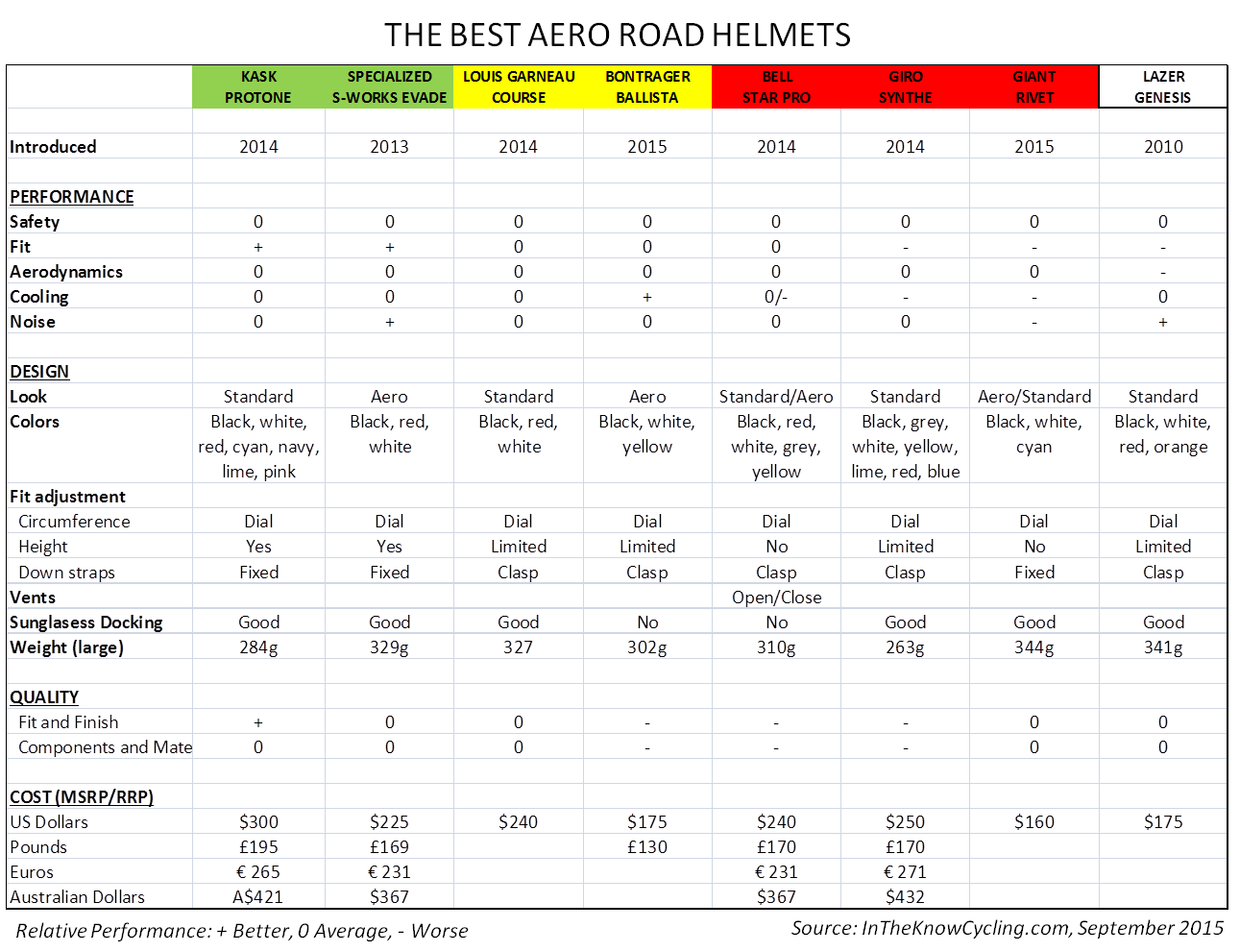
WHY TRUST THIS SITE AND MY RECOMMENDATIONS
In The Know Cycling is for road cycling enthusiasts like you and me who want to know what gear we should get next and where we can get it at the best prices from great stores. I and my fellow In The Know Cycling testers do hours of analysis on an entire category of cycling gear and incorporate insights from other independent reviewers and riders I trust for each review.
To eliminate potential conflicts or perceived bias, I buy or demo and return all the gear we test and don’t run any ads on the site. I also don’t go on company-paid product introduction trips, rewrite and post announcements of new gear as “first looks”, accept articles paid for or submitted by companies, stores, PR firms or guest authors, or charge for any content on the site.
My only influence is what I think would be best for you, my fellow roadie. This is my passion, not a business.
You and I together make this site possible using a simple and transparent model. I find and provide you regularly updated links to each piece of gear or kit I’ve reviewed. Those links take you directly to the lowest priced product listings at online stores that have the highest customer satisfaction ratings amongst the 100 or so stores I track. When you click on and buy something at the stores through the red links, they pay the site a small commission that covers the gear, review, and site costs.
If you get value from this site and want me to keep cranking out reviews, click on the links and buy at the stores they take you to. You will save money and time while supporting the creation of independent and in-depth gear reviews at the same time. If you prefer to buy at other stores, you can still support the site and new posts by taking a pull here. Thank you.
——————————————————————————————————————————-
Contents – The Best Aero Road Helmet
Keep reading or click on any of these links to go directly to another section of this review
——————————————————————————————————————————–
WHERE TO BUY YOUR AERO ROAD HELMET
As with any cycling product these days, an important question is whether to buy it at an online or physical store. With helmets, it kind of depends on whether you live near a well-stocked store or not. If you do, you can try on helmets at your local shop. Helmet prices were only slightly better (10-15%) sold at online stores and in some cases, they were essentially the same. So, if you find something you really like locally, you won’t be paying much extra to buy it at the shop.
That said, most bike shops carry only selected brands and within those, selected colors and sizes. Most of the sizing charts are the same so, for example, if you are a medium in one helmet you are very likely to be a medium in another. And the 30 seconds you are wearing the helmet you are considering in the store with the salesman telling you how good you look while you feel a bit awkward walking around with a helmet on and peeking into a small mirror on a sunglasses rack may not be the best way to decide on a new helmet.
For this review, I looked at all of the helmets I bought at one of several bike stores near me. I ended up buying the Specialized, Giant and Bontrager aero road helmets at bike shops and bought the Bell, Giro, Kask and Garneau online.
I found the online experience far superior. I looked up the helmets in the size and color I wanted and for the best price without getting out of my chair, entered in my card information and got them delivered to my door in a couple of days. I wore each of them around the house for a while adjusting the fit before ever going out on my bike, got some feedback on how they looked from the people in my life who offer the most honest opinions (my oh-so-hip kids) and spent as much time admiring or hating each helmet on me as I wanted. Both online stores I ordered from were ready to give me a return label if I wanted to send one or more of the helmets back for any reason.
Conversely, I made multiple calls to multiple local bike shops to find the helmets I was looking for, had to special order a few, and made multiple trips to the stores I ended up buying them at. I’m already a committed online shopper; I look at this experience chasing helmets around at local bike shops as another case of lost riding time.
Now that I’m done with this review, I’m keeping one helmet and selling four on eBay. I returned a helmet that was defective and another was so uncomfortably hot and loud that I took it back to the store.
CANDIDATES
For this review, I evaluated seven aero road helmets. In alphabetical order, they are the Bell Star Pro, Bontrager Ballista, Giant Rivet, Giro Synthe, Kask Protone, Louis Garneau Course, and Specialized Evade. They retail from approximately $160/£115/€145/AU$200 to $300/£210/€270/AU$360.
As a standard helmet comparison, I also used my two-year-old Lazer Genesis model the company still sells for $175/£125/€160/AU$120 retail. It’s somewhere in the middle of their road helmet product line with a couple of models more expensive (up to $210) and a few less expensive.
Here’s how the seven aero road helmet candidates and my standard one look lined up against each other. More photos at different angles are included with the review of each helmet below.

I didn’t evaluate any of the aero road helmets that are essentially standard road helmets that come with clip-on tops to cover the vents. These include the POC Octal Aero, Scott Vanish Aero, MET Rivale and Lazer Z1 Fast. The ‘put a lid on it’ design of these helmets doesn’t seem very practical to me for most road cycling enthusiasts and suggests an absolute minimum amount of engineering to produce a road helmet that is more aero. I’ve also got to believe these helmets would be pretty uncomfortable on a warm summer day. I expect some these companies will eventually offer a true aero road helmet.
CRITERIA
As with all In The Know Cycling reviews, I consider four groups of criteria – performance, design, quality, and cost. Within your chosen budget, I believe the performance of a product is paramount. Design can lead to good performance (or not) but all too often companies market their design (and cycling media write too much about it) as the basis of product evaluation. So you get an overemphasis, for example, on weight or product feature differences that matter little to the actual performance of products and a lack of comparison of performance differences like stiffness or aerodynamics that are often harder to measure, quantify and market but that should be what you use to decide what to get.
For aero road helmets, these are the criteria within each group that my research suggests are most important:
Performance: Safety, Fit, Aerodynamics, Cooling, Noise
All bike helmets should have a safety compliance sticker showing they meet a credentialed safety standard. Helmets sold in the US must meet the CPSC (Consumer Products Safety Commission) standard. All the helmets I evaluated for this review do. Other countries or regions also have groups that set safety standards for helmets including Australia and New Zealand (AS/NZS), Great Britain (BSI), Canada (CSA), Europe (CE), Japan (JIS) and Sweden. Helmets must meet these standards or stores generally won’t carry them.
Consumer Reports, a highly regarded US independent consumer testing publication, ran tests of 23 helmets this year (summary here) including those from all the major brands (though none of the aero helmet models I reviewed). Some performed slightly better than others in their impact tests but all the helmets passed Consumer Reports’ own safety tests, which appear to me to be tougher than the CSPC ones. Note, there was no correlation between the helmet’s price and impact performance level.
Helmets with a MIPS system (Multi-directional Impact Protection System) are being sold by a growing number of companies now with the largest helmet manufacturer, Bell, the owner and leading proponent. The concept is to have a layer of the polystyrene material used in most helmets that will rotate a few millimeters with your head while the harder outer shell poly-carbonate or carbon fiber material stays with your helmet to reduce the effect of impact.
It’s not been independently shown that helmets using MIPS design (or Smith’s collapsible plastic or other systems) improves impact performance. Very few of the aero road helmets have MIPS systems and none that I evaluated did. Fortunately, I didn’t fall while riding any of these helmets, therefore avoiding the chance to personally test their impact performance.
Generally speaking, round and slick surface helmets that slide easily on the pavement are said to offer the best solution to reducing impact. Aero road helmets are amongst the roundest and slickest helmets available, though again no independent tests show they are any better in reducing impact than standard ones. More discussion on this can be found here.
For the purpose of this review, I can’t separate the helmets based on their safety performance and I don’t see a reason to spend more on one helmet that meets the standard using a certain type of protection system vs. another less costly one that also meets the standard using a different type of protection system.
Fit is altogether different. Heads are like snowflakes – no two are the same – and some helmets will fit yours better than others. The same helmet that fits me well may not fit you and vice versa. A good fitting helmet leads to a comfortable ride, absolutely key when you are getting out with the kind of frequency and distance that we enthusiasts put in.
Fit is also a critical prerequisite to helmet safety. If a helmet doesn’t fit you well, all the helmet safety stickers and protection systems aren’t going to help you much. As an enthusiast, you probably have a good sense of what to do to make your helmet fit comfortably. However, fitting comfortably and safely aren’t always the same things. Since you are reading this, I feel compelled to share with you this short video on how Consumer Reports does their impact testing and how they recommend you make sure your helmet fits safely. Please watch it.
Thanks. I feel better now.
While the ways a helmet can be made to fit is a design matter that varies somewhat between companies, a comfortable and safe fit is clearly a performance matter. I can’t speak to how my fit experience will translate to yours; I can only tell you which helmets fit me best and which, based on their design, should be able to do the same for you.
The aerodynamic differences between various aero road helmets take us into the hard-to-tell realm. Companies mostly quote the relative performance rankings of tests they’ve run between their aero road and best standard road helmets. While they’ve undoubtedly run tests against competitors’ helmets, few share the results in detail (or at all) though some claim superiority. For example, Specialized says it Evade is faster than Giro’s Synthe and Giro says the opposite. Louis Garneau says its Course is faster than both of them. Etc.
Bike Radar published comparative wind tunnel tests they commissioned of aero road helmets. While the magazine often does great work, this wasn’t one of their finer moments. Unfortunately, their tests were too limited to be anything but misleading, likely due to the short amount of time they could afford paying (or were given free) for wind tunnel testing.
This is not my view – it is my unvarnished reading of the comments published at the end of the Bike Radar article by the founder and technology director of the Faster wind tunnel that carried out the tests for Bike Radar, a second set of points made by the director of helmet development at Giro also published as part of the article, and finally these comments by Lennard Zinn, the very well-regarded and longtime technical editor of VeloNews who responded to a question about these tests in his column.
Tour Magazine (available only by subscription), an independent cycling gear testing magazine with a laboratory and analytical approach, tested a baker’s dozen worth of helmets for their May 2014 issue including standard road, aero road and TT helmets. While many of the aero road helmets in my evaluation have been introduced since Tour did its testing, their analysis showed that aero road helmets had significantly superior aero performance to standard road helmets and nearly as good as TT ones.
So while I can’t tell the relative aerodynamic merits of different aero road helmets, I’m confident they, as a group, are faster than the best regular road helmets. While this is in part based on Tour’s testing and numerous company tests like these here and here (something I am loath to endorse), the superior performance of aero road helmets over the best standard road models reported by all the manufacturers tells me there is something real there.
More importantly, numerous independently conducted tests (here, here, here, here, here) have been conducted over the years and show in a comprehensive, scientifically credentialed way (i.e, lots of equations) the quantitative aero benefits of TT helmets.
From reading through all of these various tests, I’ve concluded that aero road helmets are more aero/faster than standard road helmets that most cycling enthusiasts wear by about 10-15 watts or 30-60 seconds over a 25mile/40km distance.
As with all things aero, results will vary based on rider shape and position, wind direction, environmental factors, testing protocols and other variables. While it’s quantifiably clear that aero road helmets as a group are faster than standard road helmets, an attempt to undeniably distinguish which aero road helmet is faster or a claim by one company that theirs is faster than their competition is pure folly.
I did do comparative testing of other performance factors of the seven aero road helmets against each other and against my own standard road helmet. (Hopefully not folly.) I’ll describe this in a moment. What I did notice is that I was able to ride substantially faster with all the aero road helmets than with my standard helmet on a stretch of road I picked out for this evaluation. None of the aero road helmets were that much faster or slower than another, however, even with my totally non-scientific test, to be able to rank order them.
It became clear to me that some of the helmets felt more aero than others based on the way the air seemed to flow and sound going around and through my helmet. While this comparison of “aero-feel” is totally subjective, as with many things cycling related, how you feel on your bike can affect how you perform. So if you feel like you are going faster, even though you might not be, you may put out a little extra effort to actually make you go faster. This is both the folly and reality of design and marketing.
Since most of us cycling enthusiasts ride during several hot months of the year and our heads heat up even in the cooler ones, the helmet’s cooling ability is an important performance criterion. Fortunately, at least for testing purposes, I’m one of those people who heats up pretty quickly and can overheat if not careful.
So while I measured each helmet’s cooling performance anecdotally versus scientifically (no, I wasn’t wearing a thermometer under my lid), if one helmet didn’t cool well relative to another including my standard multi-vent non aero road helmet, I was going to notice.
Finally, I attempted to judge the relative noise of each aero helmet. I tried to determine if the shape of the helmet and the way the air passed through it and by my ears was annoying or made it more difficult to hear the road noise or have a discussion on a group ride.
Again, this noise testing was anecdotal and personal. While my ears aren’t as big and don’t stick out like the Disney elephant Dumbo, I did notice differences between helmets and, with some helmets, differences between the amount and frequency of noise I heard while in an aero, arms and torso bent position versus in a more normal relaxed body up, arms straight riding position (see here for the aero benefits of 5 different body positions).
For the purpose of comparing the helmets on the fit, aero, cooling and noise criteria I’ve just described, I took most of the helmets out for multiple 40m/65K or so rides on both normal and very hot days this summer.
Two helmets fit me so poorly I didn’t ride them for more than a few days or until the point when I could tell they weren’t for me, and probably not for you. (Sorry not to carry my dedication to unbiased evaluation through to unbearable lengths for you, my fellow enthusiast, but this site is a passion and not a job so I have my limits.)
I also went out one day when the temp was about 95F/35C and rode my standard helmet and then each of the aero road helmets (save for one I truly couldn’t bear) on a 5.8 mile/9.3 kilometer loop that had a combination of elements that allowed a great comparison. I had the line-up of aero road helmets in the trunk of my car (see below) and after finishing a test run with one, I’d wipe my brow, enter notes into my laptop, put the next helmet on and repeat the process.
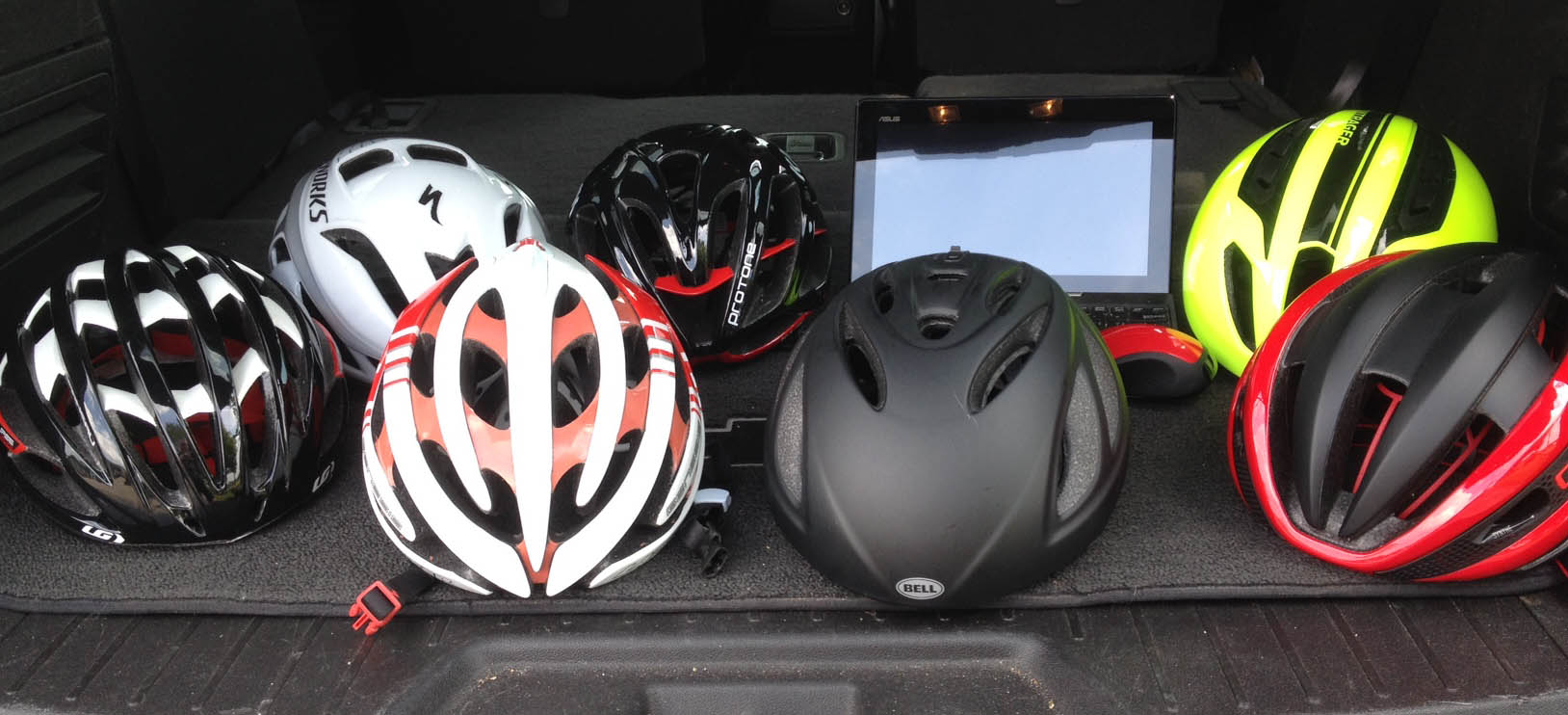
My mobile test lab (aka car trunk): From the left, LG Course, Specialized Evade, Lazer Genesis, Kask Protone, Bell Star Pro, Bontrager Ballista, Giro Synthe
The loop started out with a three-quarter mile long flat section into what was about a 10-knot headwind followed by some moderate 2-4% rollers for about mile. I then had a series of ramps ranging from 5% to 10% also for about a mile. Downhill for three-quarters of a mile, some more rollers up to about 5% for another mile and a half and then a flat to 1.5% descent for the last three-quarters mile where I could really open it up.
This combination of terrain and heat allowed me to make a good comparative evaluation about the fit, cooling, noise, and aero feel for the group of helmets and that added to my earlier observations about each helmet from longer rides when I wore only a single helmet on a given day.
Design: Look, Colors, Fit Adjustments, Vents, Sunglasses Fit, Weight, Material, Mold Technology
For some people, the most important design factor and perhaps the most important factor altogether is how the helmet looks on us. (Of course, I’m not talking about you!) Some on my group rides do appear to care about how we look… uh… how they look on the bike (ok, may you and me too… but just a little). The helmet is a big part of the look, especially if it looks odd or different. So I’ve tried to comment on the look where I have an opinion.
Sprinkled in above and further down in this post, you can look at (or look away from) a ton of photos of me with these different helmets on from different angles to see what they look like on your average enthusiast rather than on a company supplied model wearing one taken from the best angle. If I had a square jaw or my wife’s beautiful smile, these photos would look a whole lot better. On me, you are forced to look mostly at the helmet on an average head. I guess that is the point.
I also ordered the most basic color helmets I could find, usually black, to get as close a comparison of the design as possible. As I had to buy some at local bike shops who couldn’t get me the black versions in a reasonable turnaround time, there are a few that aren’t black. As you will see in the helmet comparison chart, some of them are available in a multitude of colors while others offer just a few choices.
I’m not very fashion savvy (as my wife will readily tell you) but when something looks butt-ugly on me, I’ll usually figure it out or some friend will kindly tell me I look worse than normal when I join them for a ride, but they can’t figure out why. I did get that on a couple of group rides when I wore some of the less attractive lids.
Fortunately, I also have a young daughter and son who are both very fashion conscious, albeit about different things. They are quite blunt and specific, in a loving sort of way, and gave me some good feedback to add to that of my riding partners.
While all of these helmets are distinctive looking compared to the standard road helmet, to my eyes three of them (Kask Protone, Louis Garneau Course, Giro Synthe) looked more like standard road helmets than anything approaching aero time trial ones. They had vents all over but their backs were more rounded than pointed. Two others (Specialized, Bontrager) looked more like vented aero helmets with longer, more tapered than round backs. The final two had attributes of both standard road and TT helmets, one less vented like an aero helmet and more rounded like a standard one (Giant) while the other (Bell) was more vented like a standard helmet but with no vents on the front like a pure aero one. I didn’t care for the look of either of these two.
The way in which you do fit adjustments varies from helmet to helmet. All have the dial at the back to adjust the circumference of the strap that surrounds your head. This is standard fare on today’s good helmets but not usually the case in the mid-tier road helmets that typically sell for less than half of what the average aero-road helmet does.
Only a couple of the aero road helmets have a good adjustment mechanism to easily set the height of that circumference strap (Kask, Specialized). With others you had to disassemble some of the strapping that supports the back of your head or had nothing at all, limiting or preventing a good fit in some cases.
What I found distinctive and refreshing was that some of these had the straps that come down from your helmet and were sewn or fixed where they come together under your ears rather than threaded through the typically adjustable clasp. I’ve often found the straps that use clasps to have so much range built into them that getting the adjustment just right is a bit of a hassle and the clasp often loosens or comes undone and isn’t very comfortable against your face in the first place. You can see in the photos below which of these helmets have fixed or clasped straps
The sewn or fixed strap mechanisms on all the helmets that had them fit me fine, were more comfortable and allowed the straps to lay flatter against my face rather than the clasped ones. The better fit of the clasp-less helmet also forced me to follow Velominati Rule #37 – The arms of the eyewear shall always be placed over helmet straps.
The number and placement of vents are clearly a design differentiator between these helmets. These designs can produce the desired aerodynamic and cooling performance, or not, as I found between two helmets that had very front similar vent designs to my naked eyes but were polar opposites in cooling performance.
While the two helmets above appear to have a similar front vent design, the Bontrager Ballista helmet on the left was cool with the air flowing through and moving my hair even on the hottest days while the Giant Rivet on the right was hot (and loud) with little air flow on a typical summer day.
I focused on how cool they felt to me under different scenarios, a performance rather than design criterion. Vent design also contributes to the look though it’s not likely that look played into the helmet designers’ vent layout, or at least I hope not too much!
Sunglasses fit is important both when you are riding and for me and others, when you aren’t. Clearly, you don’t want your sunglasses to be banging against the front or side of the helmet. Even though some of these helmets came down pretty far on my forehead, I never found this to be an issue. If you wear bigger sunglasses than I do, this may be a problem with some of the helmets that come down over a good amount of your forehead.
In one case, I did find that the ends of my sunglasses arms messed with the strapping near the back of the helmet. I would have never caught this in the store as I wouldn’t have thought to test the fit of my helmet with my sunglasses on. (How vain!) Word to the wise: bring your sunglasses with you if you test these helmets in the store and wear them when you test them at home.
When I’m not wearing my sunglasses I want a place to put them. I like to be able to flip them over and run the arms into a couple of vents of my helmet and have them rest flush against the front. This gives me quick access to them when I’m out on a ride and it goes from dark to dawn, bright to cloudy or dusk, and rain to shine. Also, being able to store them in the vents of my helmet between rides gives me one less thing to remember or find when I’m looking to get out the door.
Your helmet’s weight is just another one of those things which you probably never thought about and which makes no difference in the overall scheme of things. But since there are some weight weenies out there amongst the aero geeks and because the helmet companies list it, I’ve measured it too.
I have a big melon so all the helmets I wore and weights measured were for size large. The helmets ranged from 263 to 344 grams with most in the 300 to 330-gram range. If you really like one helmet over another but can’t pull the trigger because it weighs 25-50 grams more, which is an ounce or two, even though the fit and other criteria may be the same or better on the heavier one, I can’t help you.
The materials used in these helmets are all pretty similar. I’ve noted where they are different though, again, I don’t think it determines their safety performance as much as it might affect the molding shape they are able to achieve. Most of these helmets are also made with what’s called “in-mold” mold technology where the shell and liner are molded and bonded together rather than having to be glued or taped after being molded separately. This technology improves the amount of impact a helmet can absorb and provides more design options, for example, to make the helmet more aero or decide where to put vents without affecting the helmet’s structural integrity. You can read more about these two design considerations here.
Quality: Fit & Finish, Components, and Materials
You get a pretty good feel for the fit & finish of a helmet when you put it on and ride it even a few times. How good is the paint job, the gluing of Velcro pads, the application of logos and stickers, etc. Does it look and feel like it’s well made or does it feel like you are wearing something that’s cheap?
A similar question applies to the components and materials like the straps and clasps, the circumference adjuster and the pads that line the helmets. These contribute to the comfort and safety fit performance criteria but also give you a sense of whether you are getting something that feels like a quality product or not.
Cost: Purchase price, Warranty
These aero road helmets run from $160 to $300 with many in the $240-$250 range. Most of the new models introduced this year are not discounted much if at all by the many stores I track. While it’s quite a range in prices on a percentage basis, it’s pretty small on an absolute one if you’ve got a helmet that fits you safely and comfortably and does well on the other performance criteria.
Most bike companies warrant their helmets for 1 year against manufacturing defects. If you crash the helmet, some will give you a discount to replace it.
If you take care of your helmet (i.e., not dropping it on a hard surface) it should last you a good long time. The helmet company MET ran a battery of safety tests on some of their models that showed they still passed 8 years after being made. Snell Foundation, which does independent helmet testing and sets standards tougher than most of the quasi-government organizations, recommends replacing your helmet every five years due to degradation of the materials used in the helmet caused by interacting with the environment and your own naturally oily head. (See here.) Most helmet companies suggest you replace them every three years but it seems that’s a bit early based on the MET tests and Snell recommendation.
In reality, it’s likely you’ll damage the shell, liner or other fixtures well before the helmet degrades, in which case you should definitely replace your helmet. Even more likely is that you’ll get tired of your helmet or want a new one before the period in which it degrades.
More likely than anything (let’s hope), your helmet will just get dirty and the straps will get stiff from you sweating into them. That shouldn’t prompt you to buy a new one. In his always entertaining fashion, here’s Simon Richardson from GCN to tell you how to keep your helmet and straps clean. Simple. Cheap.
RECOMMENDATIONS AND REVIEWS
Let me start off by quickly reviewing and showing you my standard road helmet against which I compared the aero road helmets recommended and reviewed below.
A couple of years ago I decided I needed a new helmet. I’d grown kind of tired of my old helmet. It was a bit scratched up and getting a bit grungy. None of these were good reasons to buy a new helmet, but that’s often why people buy new helmets or new anythings. So I went to my favorite LBS and asked Andy for something reasonably priced, high quality and sharp-looking.
I walked out with the Lazer Genesis, at the time one of the better helmets, or so I was told. It fit me pretty well, the colors went with the red and black theme of my bike and several pieces of kit I wore at the time, and it had a blinky built into the circumference strap dial that was on the top of the helmet. That last bit really won me over. I wore it around the shop for probably about a minute, looked into a mirror, felt a little self-conscious and wanted to be decisive. So I forked over my $150 (it retails now for $175) and off I went.
I know, not a great way to buy a helmet. On the other hand, there was no In The Know Cycling back then. I’ve had some good years with this helmet. It fits well, keeps me cool, and looks fast but I’ve had nothing to compare it to until I started wearing other helmets for this review. Oh, and I probably used that blinky a dozen times before the odd sized button cell batteries died.
After trying out all these aero road helmets over the past several months I’ve concluded that it doesn’t fit nearly as well as others, the pads and straps aren’t very comfortable in comparison and it’s not much quieter than the some of the better aero road helmets. Quantitatively, it is the heaviest helmet of those I’ve been wearing and definitely slower, or at least I’m slower with it on than any of the aero road helmets. I wore it during my warm-up for my comparison loop test and did the loop the first time through with it on so I’d have lots of energy when I did my benchmark ride. On the last section of the loop where it is flat to downhill 1.5%, I was at least 1.2 mph slower with this helmet than any of the others. Not scientific but surely a wake-up call. All of this for the blinky that I seldom used. Ugh! As that Direct TV commercial would go if I were doing it, “don’t be the blinky me.”
Anyway, here’s the photo array of my standard road helmet.
Of all the aero road helmets I evaluated, I recommend the Kask Protone and Specialized S-Works Evade. Here are my reviews of these two.
Kask Protone – Clearly the best fitting aero road helmet that also looks more like a standard one
The Kask Protone won me over in the simplest way – it’s the one I always wanted to wear. After my first ride with it, I looked forward to when I’d wear it next and regularly checked to see when it was due to come up in my helmet evaluation rotation.
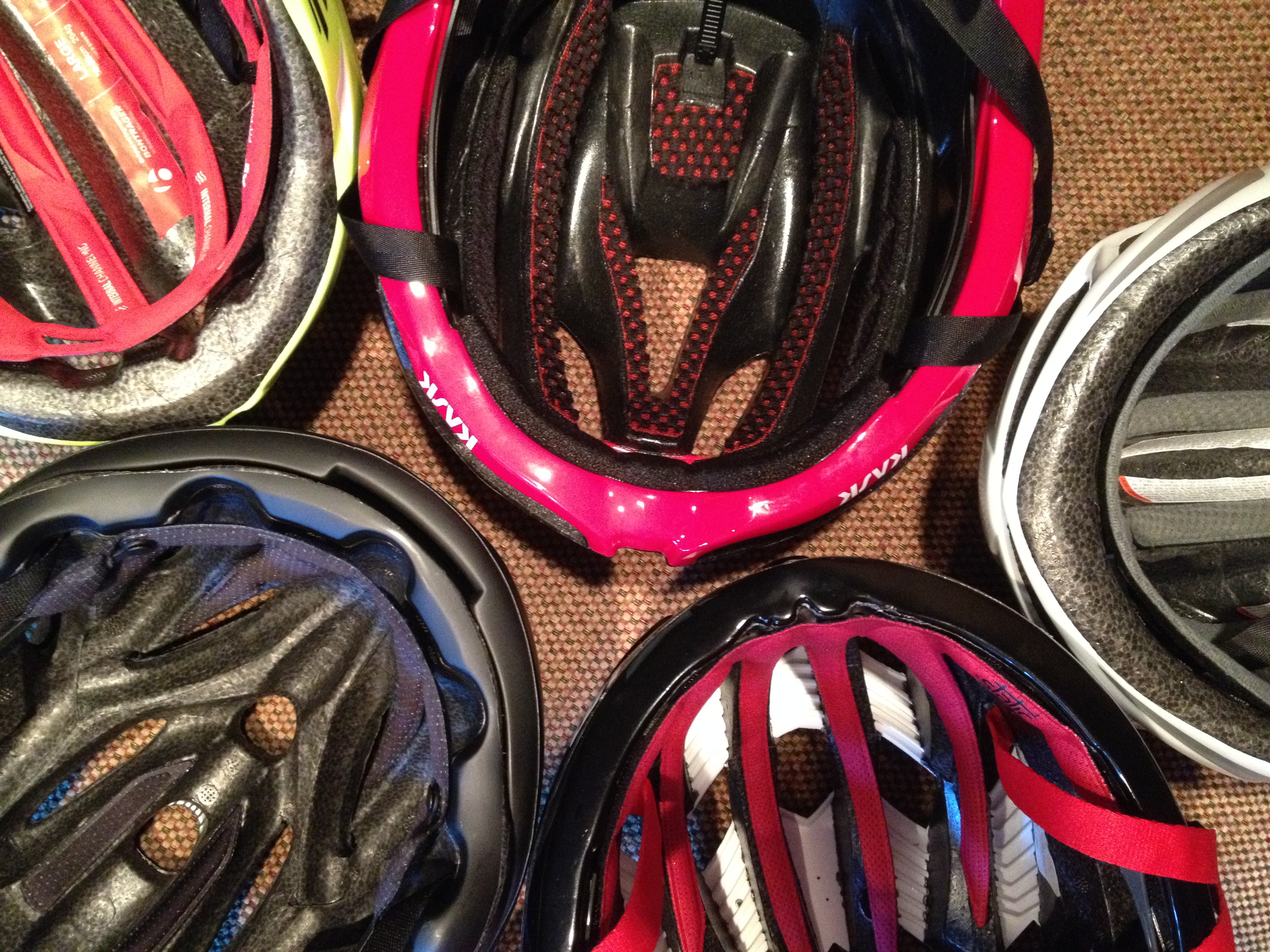
Clockwise from the 12 o’clock position are the Kask, Specialized, Louis Garneau, Bell and Bontrager aero road helmets
More than anything, the Protone fit me comfortably, securely and, if it is possible to say this for a helmet, luxuriously. The pad along the forehead is 2-3x deeper than those in any other of the helmets I tested. Rather than being part of the skeleton of padding that runs from front to back across the forehead and ribs and suspended freely or attached with a few dots of Velcro, the Protone’s forehead pads are separate from the rib pads and attached with long strips of Velcro across to the front of the helmet and surround the forehead vents. The rib pads are also thicker and they are perforated (the red dots you see are actually holes in the black pad that lies on top of the red one.)
That’s a long explanation about a seemingly small item in the helmet, but it’s just an indication of why this one fits so dang well. Along with this padding, the Kask has a slider to easily adjust the height of the circumference strap that runs around your head, allowing you to put that strap just where you want it and then dial it in to secure it. Only the Kask and Evade allow you to easily adjust the circumference strap height. The Bontrager, Giro and Louis Garneau also allow you to adjust height, but there are only a couple of positions and its a real test of your manual dexterity if you want to make the change. Another small item perhaps, but I found other helmets that came down low on the back of my head or interfered with my sunglasses lacked the ability to easily adjust the strap height or change it at all.
The Protone’s rear straps, the ones that go against the back of your head and neck, adjust laterally – in and out, allowing you to put them where they will actually support you and also not get in the way of your sunglasses or rear neck muscles. No other helmet offers that safety/comfort feature.
The Protone fixes the straps that come down from the helmet along your face and neck. The top of these straps fix to the helmet and the bottoms fix where they meet below the ears. You don’t need to mess with threading the straps through the back of your helmet or under-ear clasps. The straps lay evenly and comfortably against my face. You don’t need to play with their length from helmet to ear or and their fore/aft position. You merely adjust how much strap you want running underneath your chin. What a relief!
Finally, while it ain’t Gucci, the Protone’s side straps attach to a leather strap that runs under the length of your chin. This locates the helmet clip to the left side of your chin, opposite of where you typically have the loop to thread the excess strap material on most helmets. Tell me, would you rather have a leather strap or a plastic clip and fabric straps close to and rubbing up against your neck on a long ride? Leave it to this Italian helmet company to come up with a unique and comfortable twist on a standard design.
Right. So it fits very comfortably for long rides. What else?
The helmet cools well, on par with most of the other helmets. You don’t sense the air running across the top of your head like you do with the Specialized or Bontrager but it’s also a lot cooler than the Bell with its vents closed or the Giro whose vents are always open. The pads also don’t fill up with sweat the way those on many helmets do.
You’ll also hear a similar amount of noise rushing by your head with this helmet as you will with most of the others and, as with some of the others, the frequency of that noise goes down to a deeper hum when you get into an aero position with your arms and back bent.
Finally, and important to many, this helmet looks more like a standard road helmet than an aero one. If you want to ride fast and make it look like its more because of you than your gear, this will help you do it. If you also think some of the aero road helmets look geeky, you’ll prefer this one. My sunglasses fit and docked easily with the helmet and it comes in the traditional colors of black, white and red (and combinations of those) but also in navy and Sky blue, lime and pink for the more fashion-forward types.
Yes, it’s the most expensive helmet by about $50/£35/€45/AU$60 but all things considered, the comfort, quality and look of this helmet make it more than worthwhile. It’s fit and finish and materials are first-rate and its 20 to 40 grams lighter than the other helmets I recommend buying or suggest you consider. Most other reviewers I trust have also rated this helmet very highly.
You can find the Kask Protone in stock at the best prices and from stores with excellent customer satisfaction records by clicking on these links in the US and Canada at Competitive Cyclist and in the UK/EU at Wiggle.
Specialized S-Works Evade – Great comfort and lower noise levels along with an aero look
The Evade is a helmet that I came to appreciate more and more as I compared it to other helmets. It was one of the two most comfortable helmets of any of aero road helmets I’ve worn (the Kask being the other), was relatively quiet and had a very racy look. The helmet cooled well and somehow felt more aero on the road than most of the other helmets, perhaps because of the way the air circulated through the helmet and its aero look.
The Evade feels like it sits well above your head, putting no pressure on it. Yet it felt secure, moving very little as I shook my head left and right, front and back with the head circumference strap totally loose while doing my safety fit test.
I really can’t isolate why it feels this way. It doesn’t actually sit above your head any more than the others do. It does have a lot of vents in the front and it’s back is almost fully cut out so perhaps more of the weight is above than around your head. The Evade weighs more than most of the other helmets, though marginally, so that doesn’t contribute to its light feeling.
Only the Evade and Kask Protone have easy adjustments for the height of the plastic strap that run around the circumference of your head. Specialized calls its version the “Mindset Adjuster.” I kid you not. Must be the influence of the company’s California home.
 Mindset is a term I thought was only reserved for shrinks and business consultants, the latter a career I have practiced for years. And yes, I overused the term ad nausea working with companies to change, even transform their way of doing things. But, I never ever thought I’d find the term on a label inside a bike helmet.
Mindset is a term I thought was only reserved for shrinks and business consultants, the latter a career I have practiced for years. And yes, I overused the term ad nausea working with companies to change, even transform their way of doing things. But, I never ever thought I’d find the term on a label inside a bike helmet.
Well, whether it’s the mindset adjusters, the vent cut-outs or some other magic fairy dust they sprinkle into the helmet, my mind is clear – this helmet is comfortable and feels like it sits above my head while fitting very well.
The helmet also cooled well, about on par with the others. Similar to, though not as much as the Bontrager, I could actually feel air flowing through the helmet and over my head when I got going. This was a sensation I didn’t feel with the more standard looking aero-road helmets, and yes, it does make you feel like you are going fast.
I also liked the way it handled noise. It was louder than my Lazer Genesis standard road helmet when I was riding upright. But, when I got into an aero position, the noise not only dropped in frequency as the other helmets did but the noise seemed to quiet, which I didn’t experience with any of the others.
Specialized introduced this helmet a couple of years ago. Some have written that it is old and perhaps passed by others in terms of its design and aero performance. I can’t speak to its comparative aero performance; I don’t know anyone who can independently do so. As you can see in the video below, Specialized does provide a comparison of the Evade to the Prevail, its top-of-the-line standard road helmet (40-46 seconds faster over 25m/40km based) and full-on McLaren/S-works TT helmet (20 seconds slower over the same distance).
Specialized must have felt the Evade was still worthy enough to be included unchanged in the 5-minutes-saved aero product line demonstration (here) they did earlier this year. They invested a lot to introduce a re-designed bike, wheelset, skin suit and other components for that demonstration. I would think if they felt there was speed to be picked up by introducing a new helmet, they would have done that too, but they didn’t.
The design of this helmet definitely makes a statement when you show up with it. I got a “Whoa Dad” from my son when he saw me put it on before a ride one day. Not sure if he meant you look way cool or you look like a real dork but I clearly left an impression. If you like a more aero than standard looking design, the fixed down straps, easy sunglasses docking and good quality feel of this helmet, along with the superior fit and lower noise levels, this is definitely the helmet I’d recommend. Other trusted reviewers have also been very positive about this helmet.
The Evade comes in white, black, and red with some having red or high-vis color outlining. It’s available in the UK/EU Tredz 10% off w/code ITK10, CycleStore.
The Louis Garneau Course and Bontrager Ballista performed on par on most criteria but didn’t fit me well. They might fit you better and are worth consideration..
Louis Garneau Course – Good looking, standard shaped helmet with a free-floating back support strap
The Louis Garneau Course is a helmet whose best and worst attribute is its fit. Unlike the helmets above that I recommend, I liked the fit of the front and sides of this helmet but I couldn’t get the back to fit me well. Since heads are different, it may fit you better than it did me. If it does, the other performance and design attributes of this helmet are decent enough to be worth giving it consideration, though I don’t believe it’s on the same level as the Kask or Specialized.
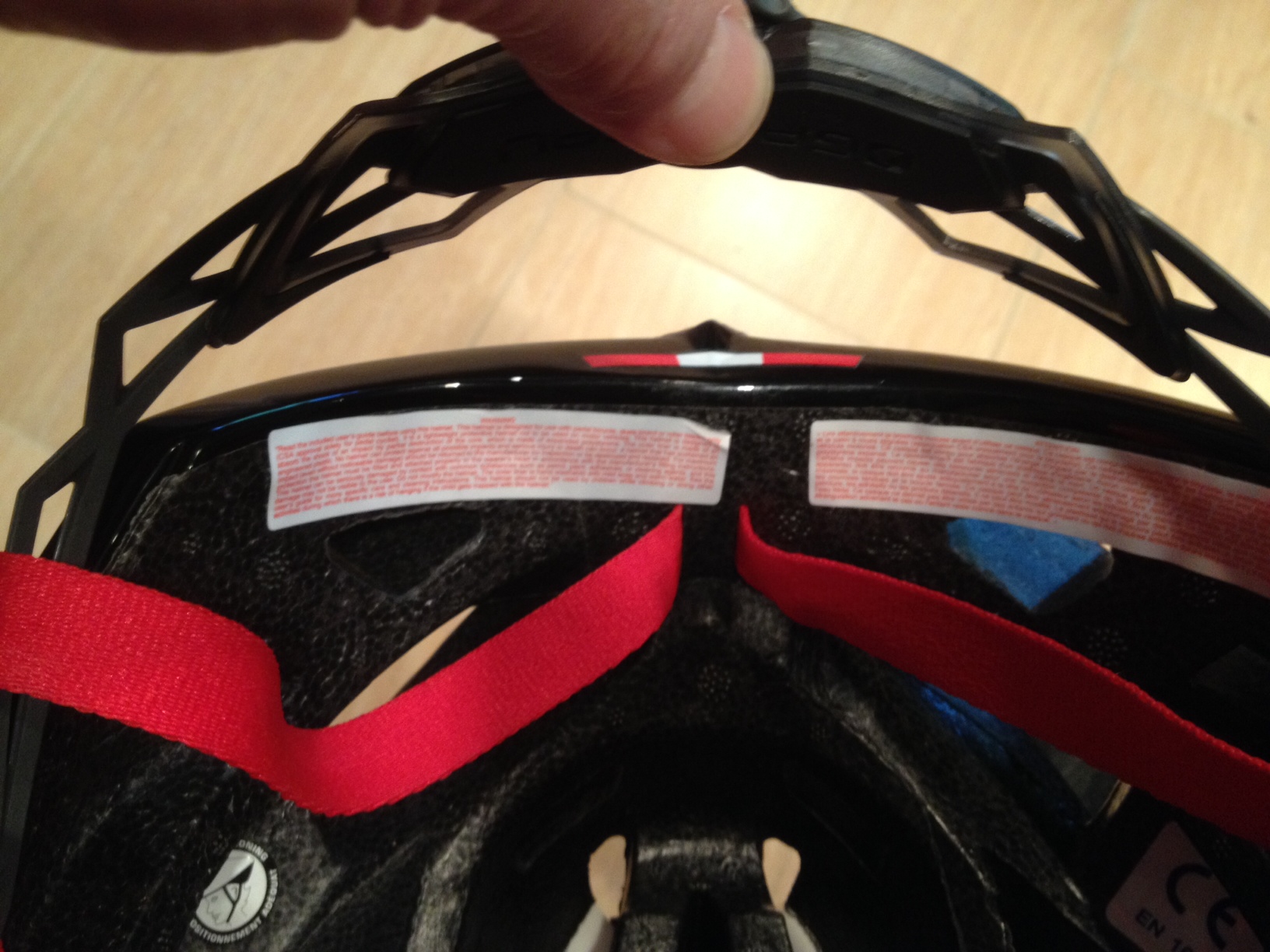
The backstrap isn’t anchored to the rest of the helmet which allowed it to slide into an uncomfortable position on my head when I dialed it in.
With the Course, the back circumference dial and the plastic support strapping it attaches to aren’t tied into the rest of the helmet like others that use either cloth straps that thread through the back strap and run down toward your ears or a height adjustment mechanism that anchors the back strap to the back of the liner. Sure, there’s a way to alter the strap angle to adjust the height. But, this is done where the strap attaches to the helmet at your temples using one of several slots and then securing it with Velcro.
I didn’t find this mechanism very effective at holding the height you wanted. Rather, the strap essentially floats free until it slides into a position when you dial in the circumference strap.
I can see where this gives this helmet the option to fit a wider range of head shapes by essentially allowing an infinitely variable height adjustment. Slide it up or down and the back of your head and then turn the dial to keep it in place.
In practice, when I started turning the dial, the back plastic support strap slid down and grabbed the back of my head either right at the lip of my skull or just underneath it. Without the cloth or plastic straps to anchor it and distribute the circumference strap pressure, all of that pressure ran along the back of my head. My solution was to loosen the dial to ease the pressure. That is probably not a safe solution. The helmet moved more than I would like when I shook my head, although it made the helmet much more comfortable when I eased off the dial.
The helmet cools well and is about the same as many of the others when it comes to the amount of noise you’ll hear when underway. The side straps connect under your ear using clasps; they work fine but I now prefer the feel of a fixed or clasp-free attachment design. You’ll also have to trim the ends of the straps or tuck in the extra length of material. Fit and finish was a little underwhelming. You see a lot of the dull finish EPS liner material exposed along the front and side seams between the shiny top and bottom shell material.
The Course (available at Competitive Cyclist, Amazon) is generally a good-looking helmet to my eyes. Its shape is more like a standard road helmet than an aero one. If you buy this helmet, I’d suggest you go with the white or red version. The material that braces its top ribs on the black one are painted bright white and will probably need some regular work to keep clean. The braces on the other helmets are black.
Bontrager Ballista – Low price, great cooling but a fit that may not work and quality level below most of the rest
Similar to the recommended Specialized S-Works Evade, the Bontrager Ballista looks more like an aero than a standard helmet and feels like it’s sitting high above your head. It’s a nice sensation. You feel like you are riding fast.
In reality, the helmet’s front shell and rear circumference straps and dial actually sit lower than most of the helmets I tested. The rear strap fit was the issue that caused me to pause on this helmet. Those straps came in contact with the back of my sunglasses arms the muscles in my neck which reach into the bottom back of my skull. I had to unhitch the rear straps and jockey the height tab up a bit to change where it sat on my head but I couldn’t find a position as comfortable as the Kask or Specialized.
As with the Louis Garneau, it didn’t fit me well but might work for you so I’d encourage you to consider it as there are several things I really liked about this helmet.
First, it’s $75 to $125 less than the Specialized and Kask helmets respectively. That’s another set of tires. Secondly, this helmet cooled really well. It was the only helmet I wore where I could actually feel the air pushing my hair around under the helmet. Now I’m not sure if that’s the most aero design but it sure was a cooling one and felt like I was moving fast.
It’s about as noisy as most of the other helmets I wore and has rather basic straps that clasp together below the ears. The pads, strap material and stickers they use on the helmet don’t feel or look like they are of the highest quality but remember you are paying a lot less for this helmet. Sunglasses don’t dock well as this helmet’s front vents are pretty much in the center of the helmet and angle in. If you have large sunglasses you’ll also want to check that they don’t hit the front of the helmet as it comes down as low as any of those I tested.
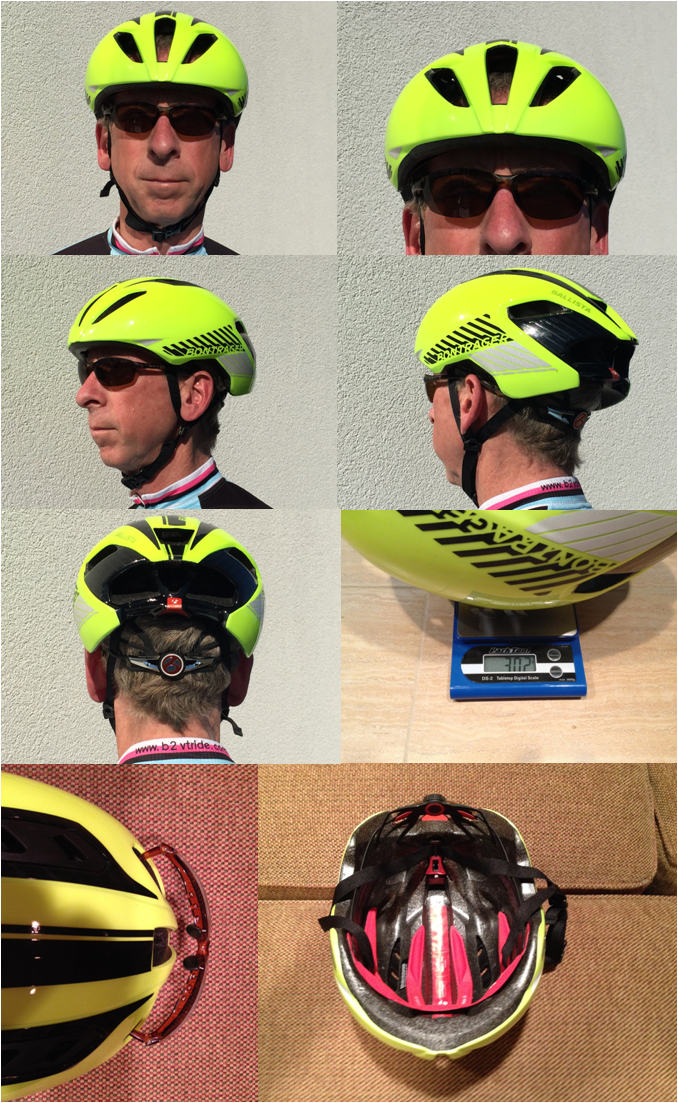
The Ballista (available at Trek Bicycle Superstore) was introduced late this summer. Currently, Bontrager is only making them in white, black and high visibility yellow and stock is quite limited.
Finally, I’d steer clear of the Bell Star Pro, Giro Synthe and Giant Rivet for reasons I say more about here. I haven’t provided store links to these helmets as I discourage you from buying them.
Bell Star Pro – An innovator that needs to up their game
I’m not a historian and there’s not much history to write in this category, but Bell probably expanded the market greatly and put the small starting field of aero road helmet makers on notice when it introduced the Star Pro helmet for the 2004 model year. Just two years later, some of this helmet’s innovations look dated or better suited to non-aero purposes.
The helmet is round and wide and looks quite different from the standard road helmet. From the front, it kind of looks like a flying saucer. Others have since come out with aero road helmets that are much more oval.
Bell promotes the Star Pro with an eye shield, essentially a visor that attaches to the helmet and replaces the need for your sunglasses. This is perhaps an homage to the time trial style helmet but, for me looks totally out-of-place on a road helmet even if it does make you incrementally faster. The shield is removable and can be “stored” on top of your helmet while riding. I’ve read mixed reviews about how well this works in practice. You can buy the Star Pro without the shield (and I did). Unfortunately, you can’t easily slide your sunglasses into the vents and they don’t go in far enough to fit flush against the helmet.

Bell’s product promo photo
This helmet’s other clear distinction is that it has a piece that slides under the vents that allows you to easily open and close off the air to them while underway. This is far more practical than covering your vents with a lid or topper that clips on before you go out for your ride the way other companies have done to make their standard road helmets into aero ones. (As mentioned earlier, I did not test these ‘clip-on’ models as I don’t think they are very practical for most roadies).
Bell’s idea is to make the helmet more aero, with the vents closed, when you want to go faster like in the opening of a crit race or in a sprint at the end. If you want a cooler helmet, you need to open up the vents, which makes the helmet less aero. Bell essentially is offering you a trade-off – go fast or stay cool – or switch off between them during your ride. Perhaps a racer can make that decision. As an enthusiast, I want a helmet that will help me go fast and stay cool.
A real benefit of this innovation is to keep the heat in and perhaps not have to wear a hat in the colder weather or keep the rain out when you are riding in inclement weather. I didn’t ride it in either but I can see the potential for this on cool fall and early spring days.
I recognize that these are mostly design features I’m writing about and I’d earlier stressed the predominance of performance over design. More about performance in a minute, but before I finish off on design, let me say that looking at this helmet on my head straight on is not pretty. While I know that you can only put so much perfume on a pig, this pig doesn’t smell any better with this helmet on. I did notice that Bell’s promotional photos and the ones used by many of the publications that have written about this helmet are mostly taken from the side, a far more attractive profile than from the front. Perhaps it’s because they are trying to emphasize the uniqueness of the vent slider rather than the nearly ventless design and saucer look of front and top of the helmet. Who knows, but here’s how it looks on this pig from the front, rear, a couple of side angles and the inside.
As far as the performance measures I can comment on, some are on par and several are below the others. The helmet sits quite comfortably around the circumference of my head and, from a safety standpoint, rests quite securely there even with the circumference strap completely loose (which is the way you should test it).
I couldn’t however, get the side straps to easily adjust and therefore couldn’t get the straps that run down the sides of my face and neck and the clips that go under my ears into a comfortable position. I also couldn’t get the neck strap forward enough; it always seemed to be encroaching on my throat. I played with this a while to the point of near frustration. It’s likely that a shop could set this up for me but, really, should it be that hard when others require no adjustment at all and fit comfortably right out of the box?
This helmet also proved to have sufficient cooling with the vents open. Below 80F/27C, I could hardly tell the difference with the vents open and closed for short periods of time. Above that temperature and going up serious inclines, you definitely wanted the vents open. Even on the flats on hot days you don’t want them closed.
Practically speaking, I found myself using the slider to regulate more how cool my head was than how aero I wanted to ride. This seemed to be contrary to what Bell designed this slider to do. Frankly, that was not something I was used to or perhaps wanted to deal with. Perhaps its best to use this helmet for its aero benefits when its a bit cooler out.
Because of the vent slider, this helmet’s liner and shell aren’t made together or ‘in-mold’ as most helmets priced in this range are. While it passes the impact tests just as the others do, Bell attempted to turn this two-piece construction into a plus by putting a less dense EPS on the liner and more dense one in the shell.
The fit & finish of this helmet was also disappointing. There’s a lot of the mottled finish of the grey polystyrene liner alongside the shiny or matte finish of the helmet shell showing through at the vents and even across the front of the helmet. My helmet’s shell with the matte black color also scratched quite easily. I mentioned earlier that I didn’t think the side clasps were well designed. Together, it doesn’t look or feel like a quality product. Others who have tested and reviewed it in non-comparative testing (here, here, here, here) have reached much the same conclusions that I have.
Bell Sports is one of the largest helmet companies in the world and also owns the Giro brand. Bell was innovative with some unique design elements like the slider and shield even if I don’t think they offer much that the average enthusiast is going to get value from. I hope they keep trying because others will always follow the lead of an 800-pound gorilla. This helmet, however, is surpassed by the smaller fries in the current field.
Giro Synthe – Fit, cooling, quality all subpar experience
Being one of the largest helmet companies in the business and an early entrant into the aero-road category, it really surprised me that the Giro missed the mark so badly with this helmet.
First off, it was hard to get to fit. It felt sloppy on my head with the circumference dial all the way out, the position you want it in to test its fit for safety. Dialed in it felt uneven, the back of the strap snug up against the back of my head when the front was set to fit comfortably. The dial didn’t turn easily and it was about half the size of most of the others.
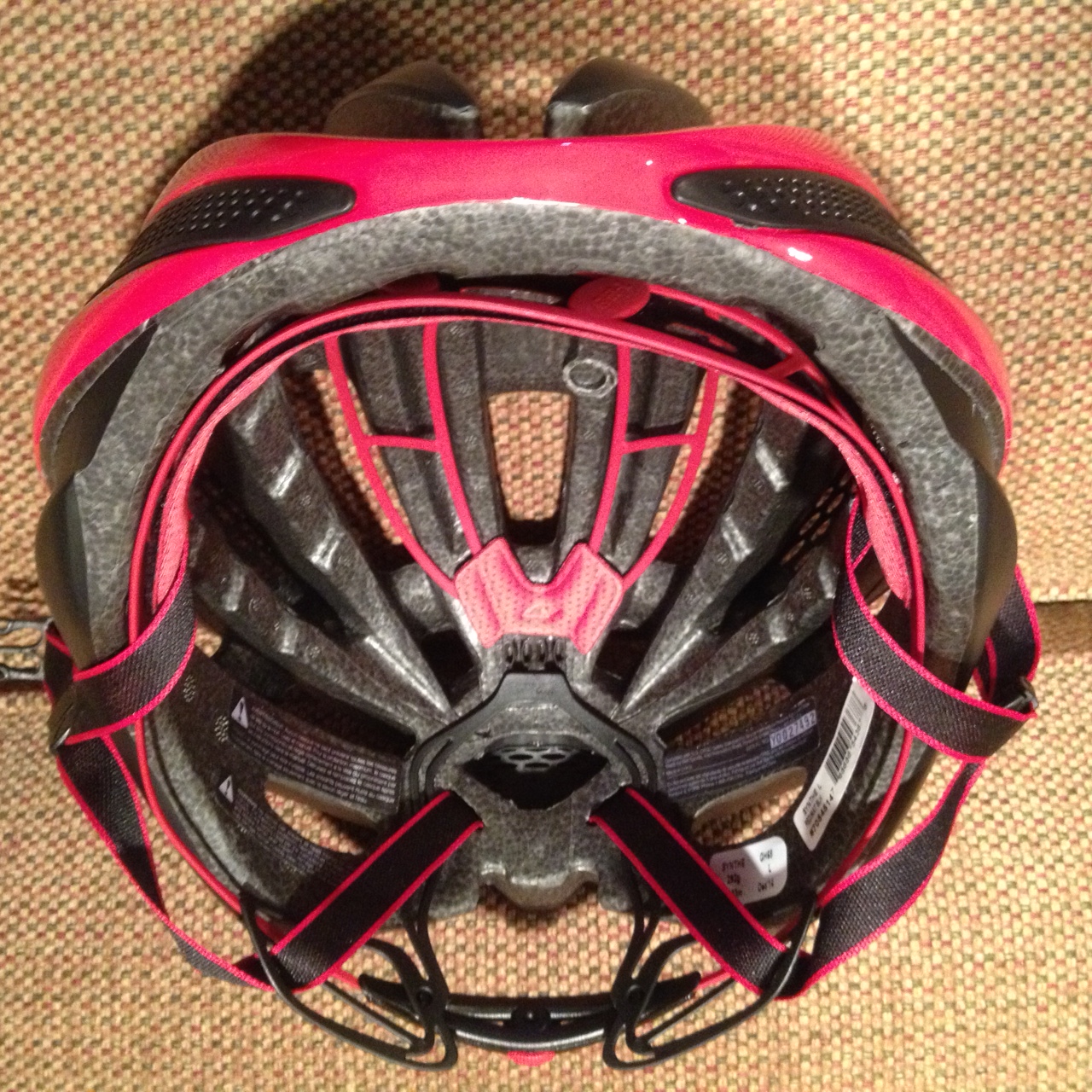
Paper thin forehead pads, none on the ribs save for the tiny thin one at the back, small dial, defective (bent) strap at the forehead and what is that molding hole in the middle of the shell? Poor quality, fit, cooling, comfort.
The forehead pads are paper-thin and there are no pads on the ribs except for a small one that sits above the line where the two innermost ribs come together at the back. The idea is for the helmet liner to be partially suspended above your head using the plastic straps instead of pads to accomplish this. It didn’t work for me and, even if it did, I’m not sure I’d prefer plastic strapping rather than foam pads separating my head from the helmet. The front left side of the circumference strap was also out of shape, clearly a manufacturing defect.
So trying to make it fit was a chore and wearing it was uncomfortable. Because of this I took it on only one solo ride and did the 5.8 mile/9.3km loop on the 95-degree day to compare it to the others.
On the comparison loop, there was no sense of cooling at all. My head was hot with the Synthe on and I didn’t cool down much even when I put my head straight into the wind to do so. It was about as noisy as the average helmet but the frequency of that noise didn’t change when I got into an aero position.
Priced in the middle of the range of these helmets, the Synthe felt like it was out-of-place. Its performance and quality seemed like that of a mid to low tier road helmet. Some reviewers like Cyclist had a similar take to my experience. Bike Radar praised this helmet in its review. I didn’t see it… or feel it the same way.
Giant Rivet – Poor fit, cooling, noise and look knock it out despite its great price
Priced lower than any other helmet in the aero road category ($160), I had high hopes for this helmet. Unfortunately, I was sorely disappointed, and I mean that literally and figuratively.
As the photos above show, this helmet has a huge rubber-like bumper that sits at the center of your forehead and is the only part of the front of the helmet that touches your head. The rest is cutout for venting. Pressure across the front of your head is focused on a spot that’s about 2 inches or 5 cm in width. Using the head circumference dial in the back only increased or decreased the pressure point, it didn’t distribute it.
Equally problematic, the helmet cooled me unevenly. My forehead always was cool with fresh air but that air didn’t seem to flow much over the crown of my head where the helmet had no vents. So I was cool at the front and hot and sweaty on top. Unlike almost all the other aero road helmets, there were no vents on the top, just the massive ones on the front and the exhaust vents at back.
As far as the aerodynamics go, I couldn’t of course judge the amount of drag scientifically but I had the sense that there was more air pushing against my forehead than normal. Maybe it’s just the way the helmet sits further down on my forehead than most others. My 5-minute high-intensity flat terrain intervals were slower than normal but it’s hard to assign that to the helmet. Too many other things going on but my mind was telling me I was going slower and the times confirmed it.
And then there was the noise. On my first day out with the Rivet, it was a sunny with modest breezes
At 20mph/32kph speeds it got really loud, like the wind you hear rushing by you riding on a powerboat. When you get into an aero position, arms bent square, back over and head down, the sound gets deeper, like someone turned up the bass and turned down the treble. It’s not easy to hear the cars coming up behind you unless you really concentrate on listening for them. Not something I want to do. Because of this, I never took it out in a group ride. Didn’t want to risk it.
I could go on. It’s big and round, almost like a globe. Not my preferred look. The sunglasses docking was aces, best of any helmet I tried. That and the fixed side straps was basically all I liked about this helmet.
* * * * *
Thank you for reading. Please let me know what you think of anything I’ve written or ask any questions you might have in the comment section below.
If you’ve gotten some value by reading this post or any of the reviews or comments on the site and want to keep new content like this coming, click on the links and buy at the stores they take you to. You will save money and time while supporting the creation of independent and in-depth gear reviews at the same time. If you prefer to buy at other stores, you can still support the site and new posts by taking a pull here. Thank you.
And please, let’s stay connected! Using the widget in the right-hand column, you can sign up to get an email when new posts come out and follow us on social media by clicking on the icons below.
Thanks, and enjoy your riding safely!
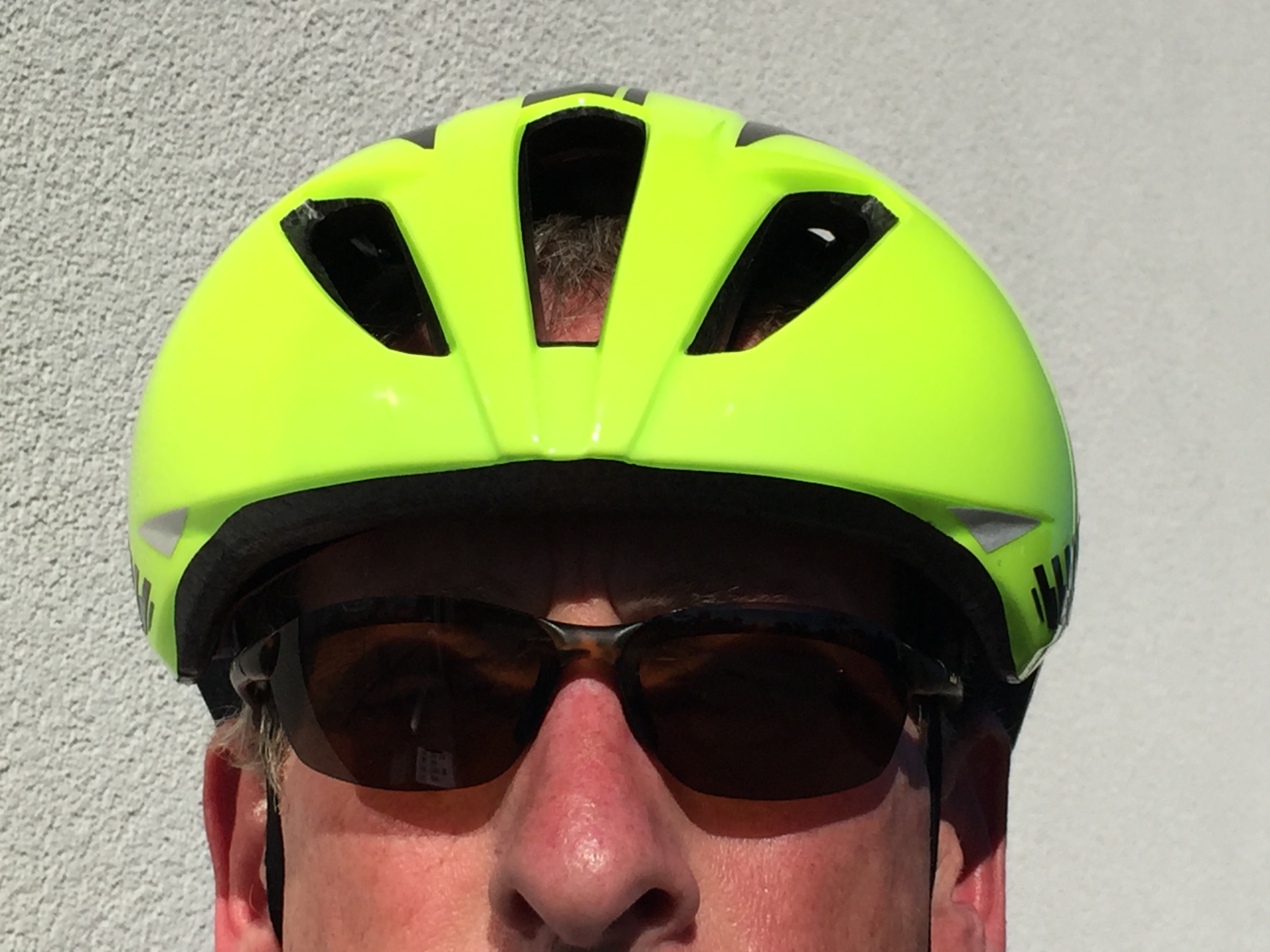

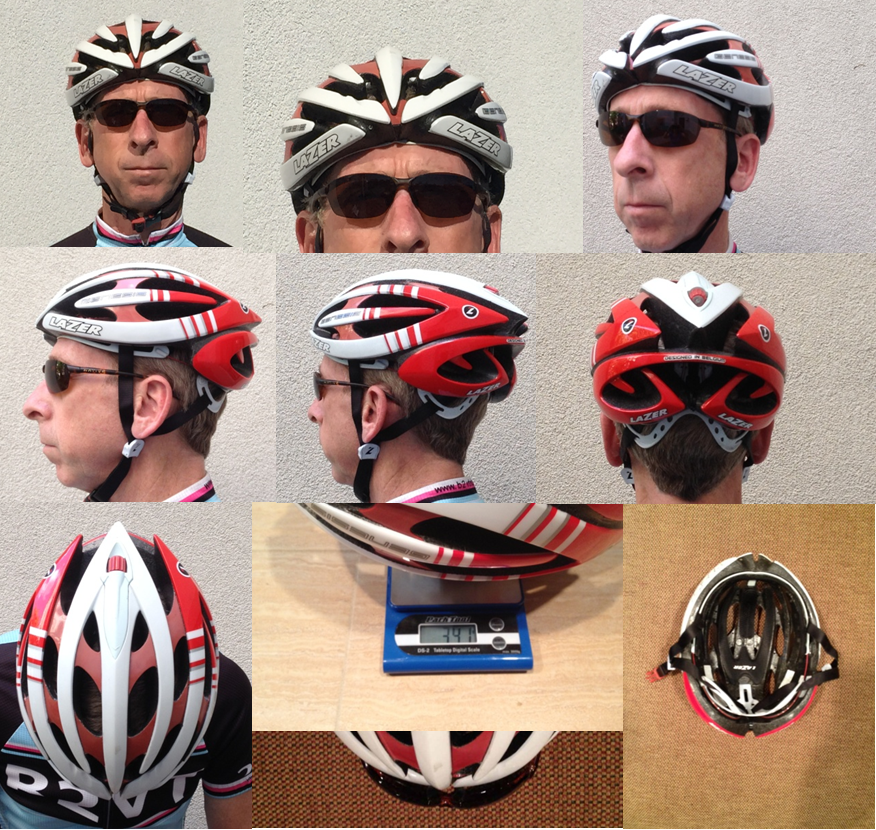
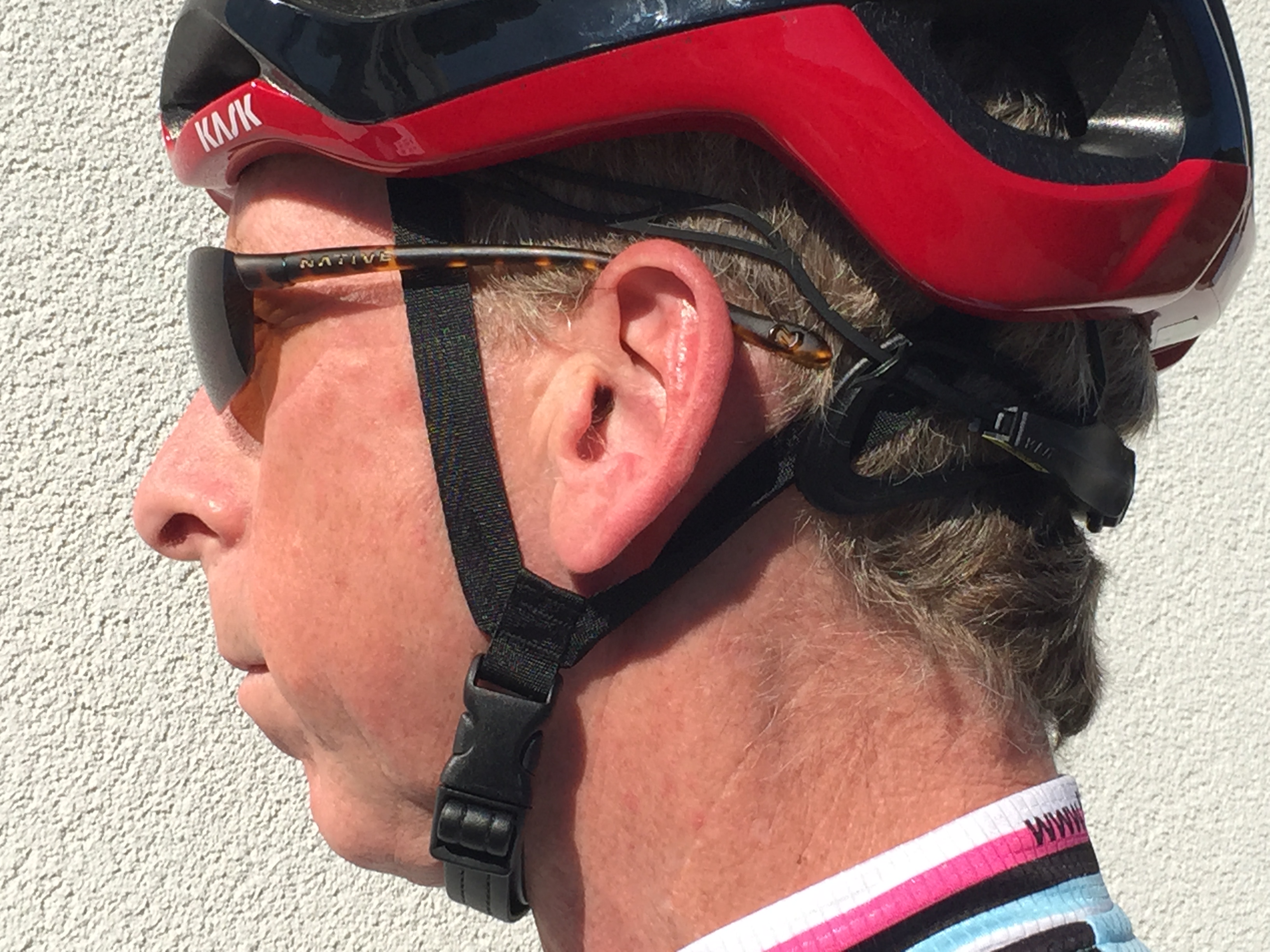
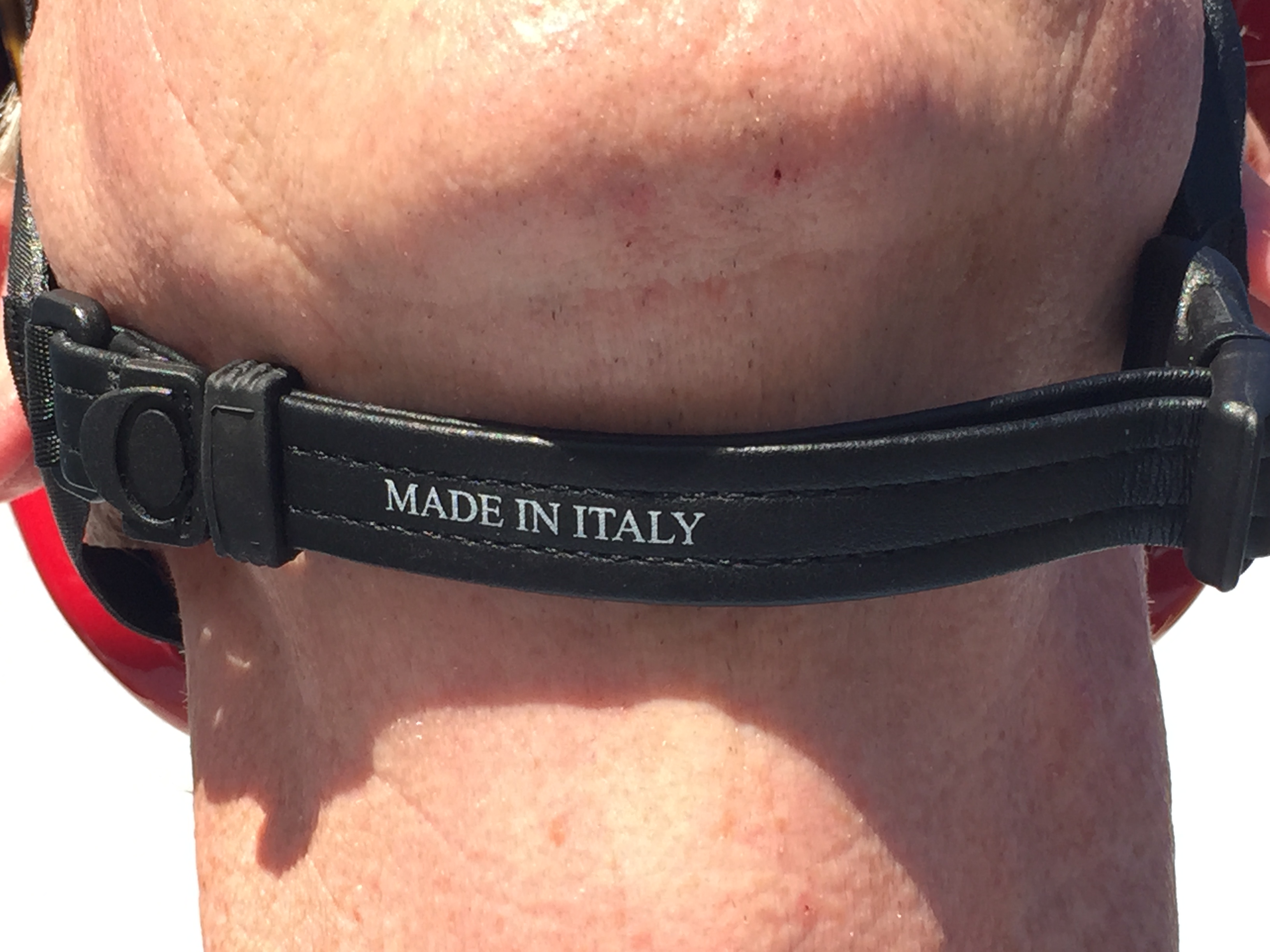
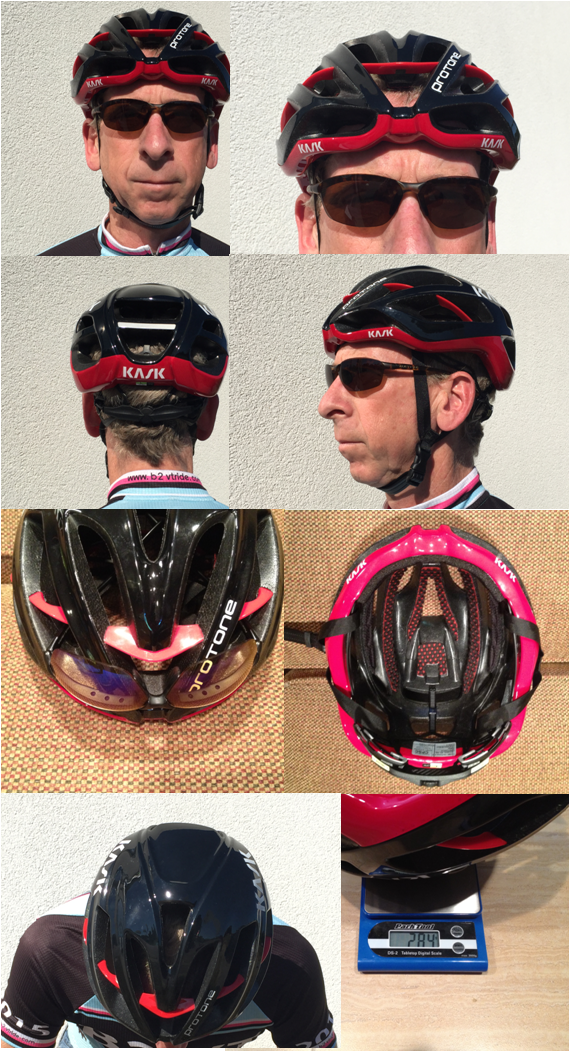
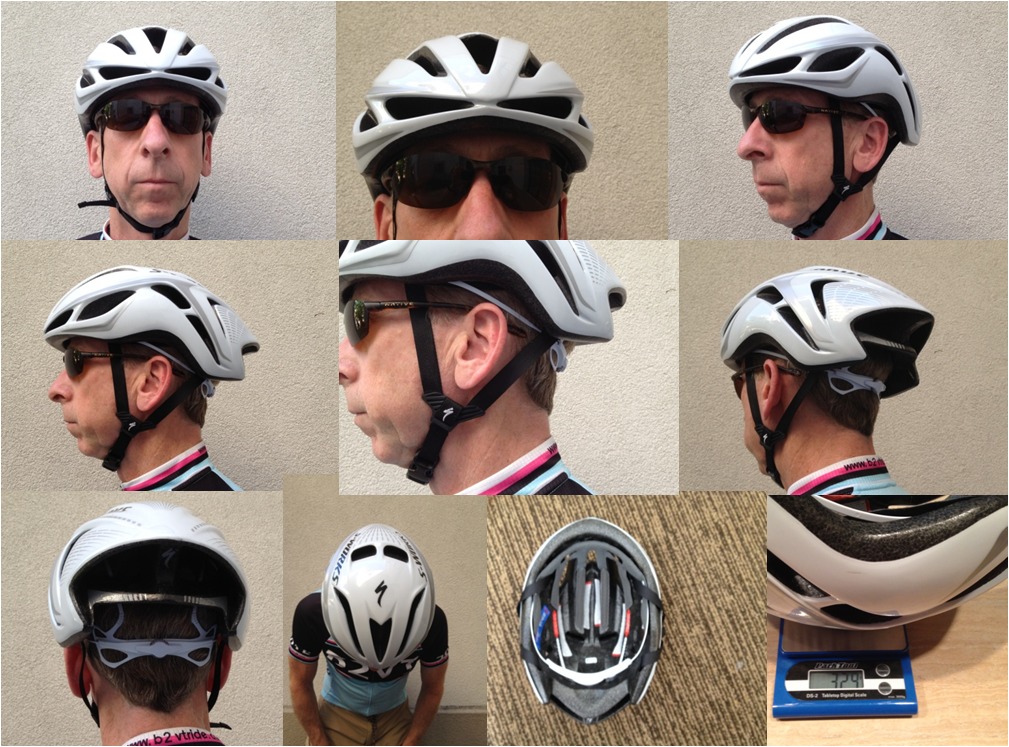

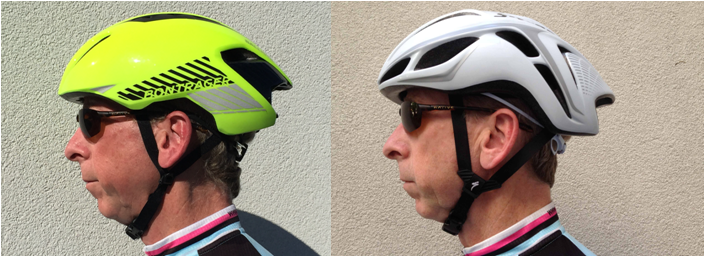
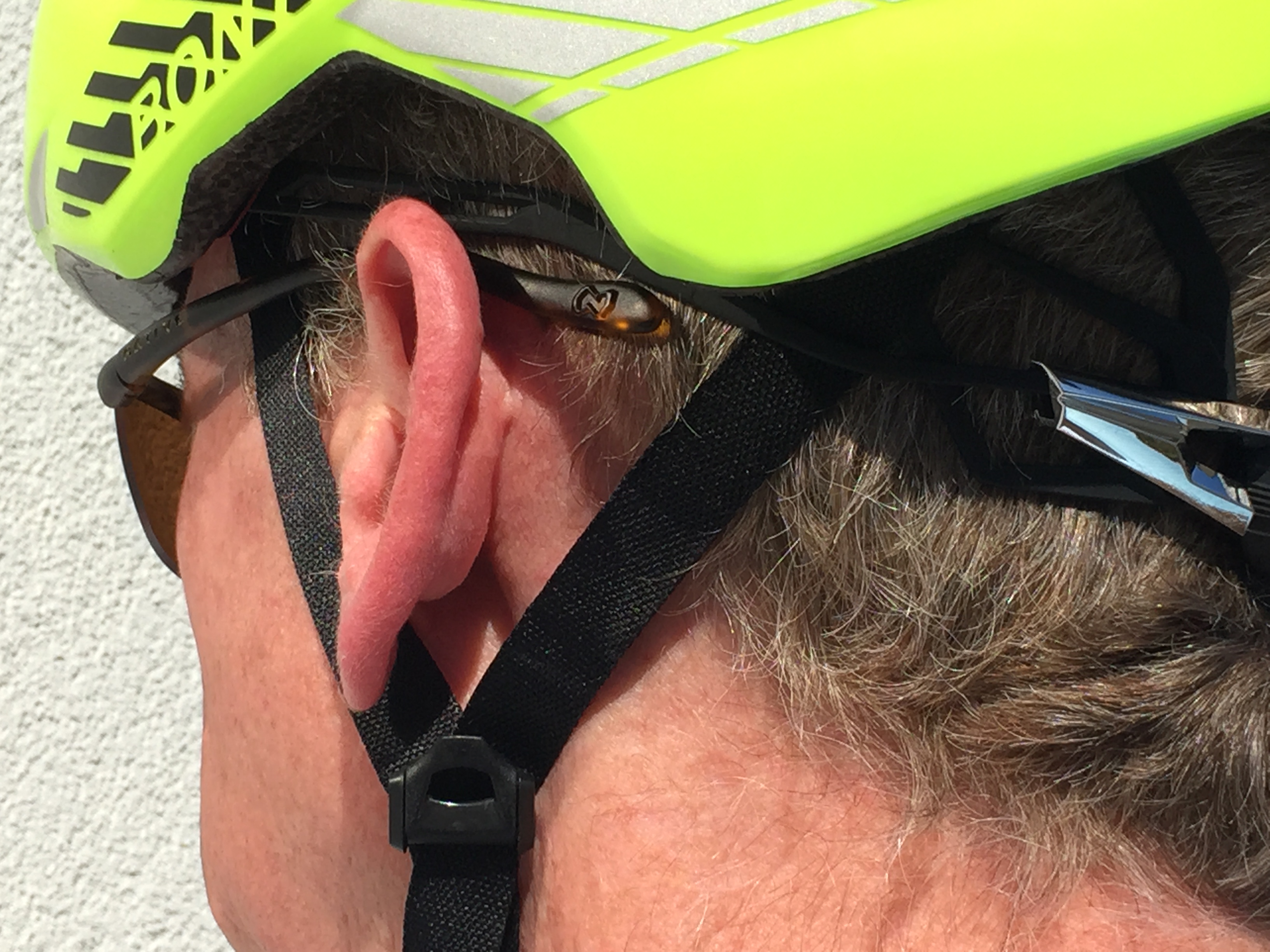
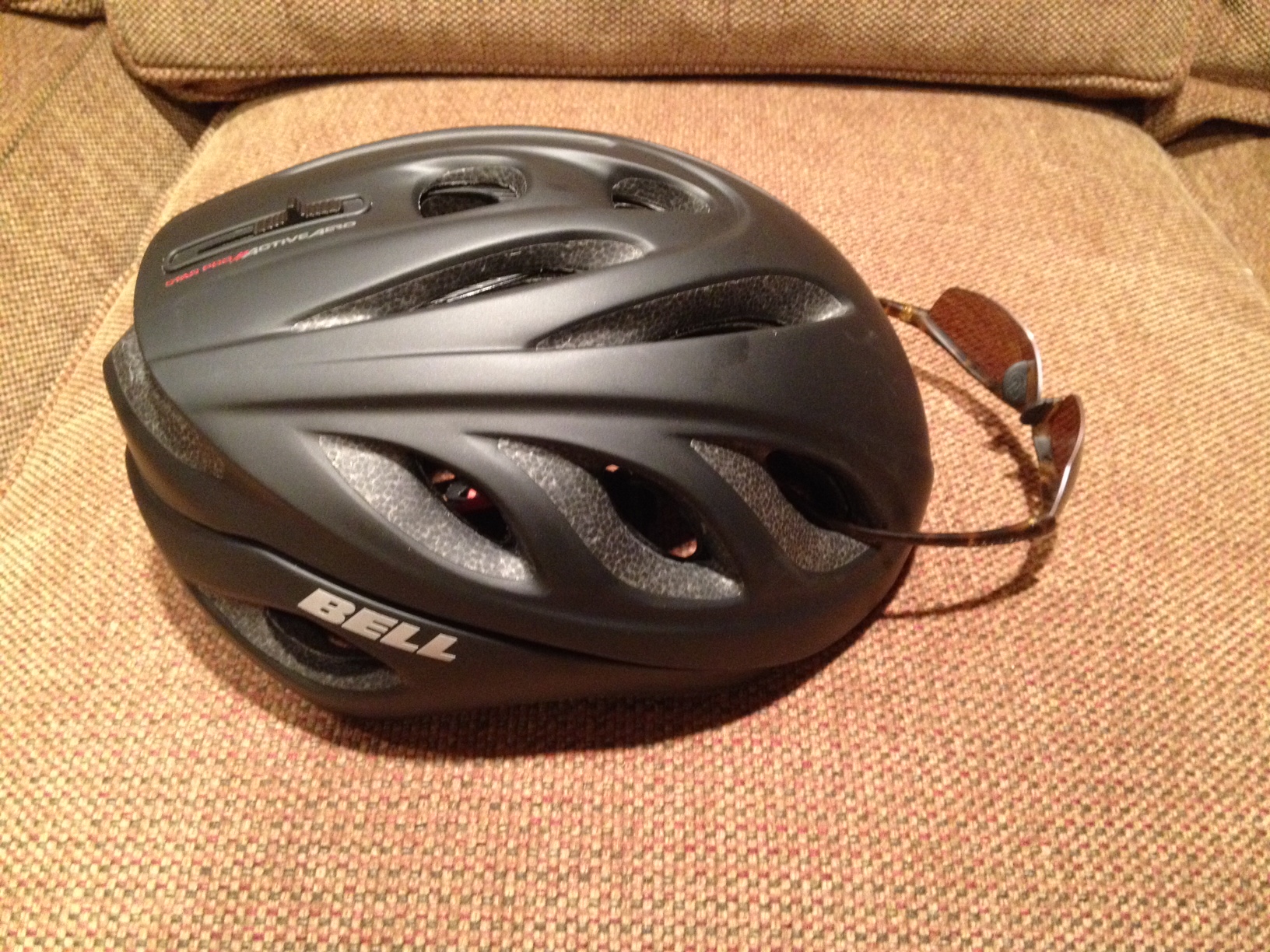
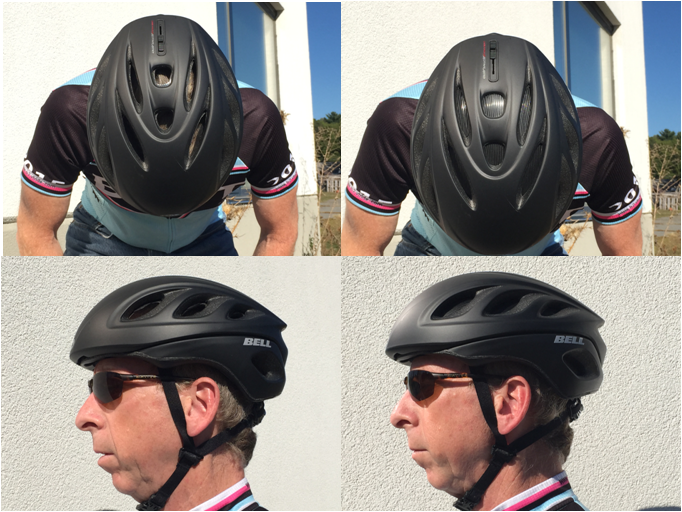
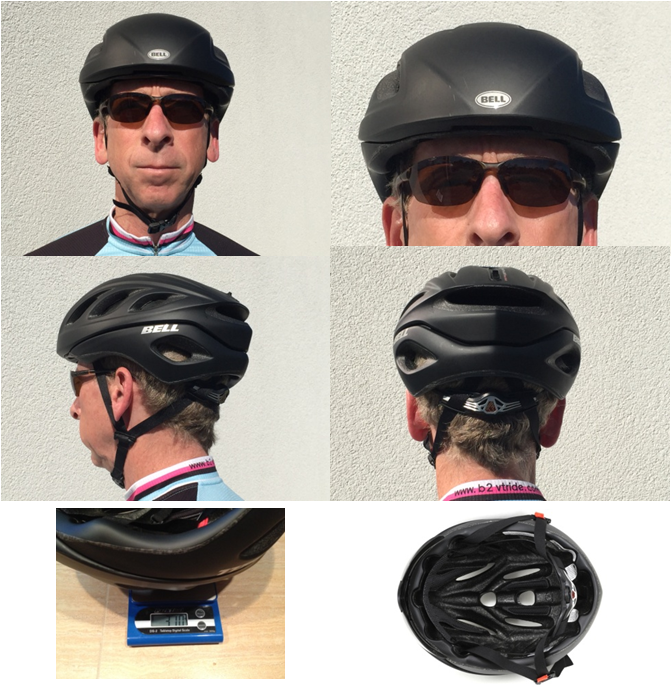
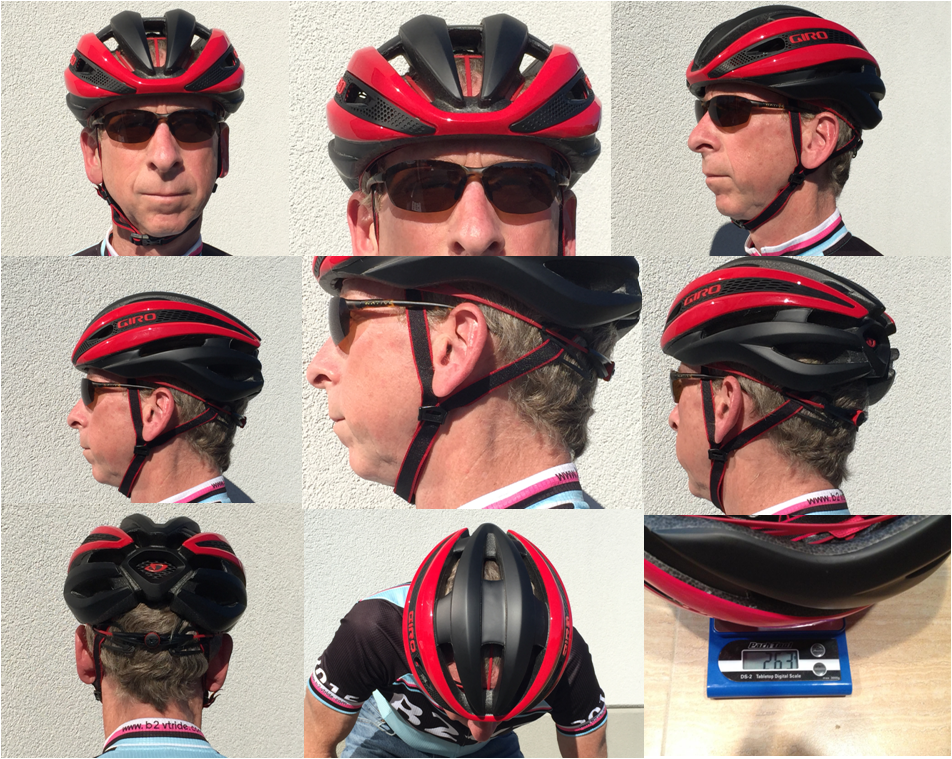
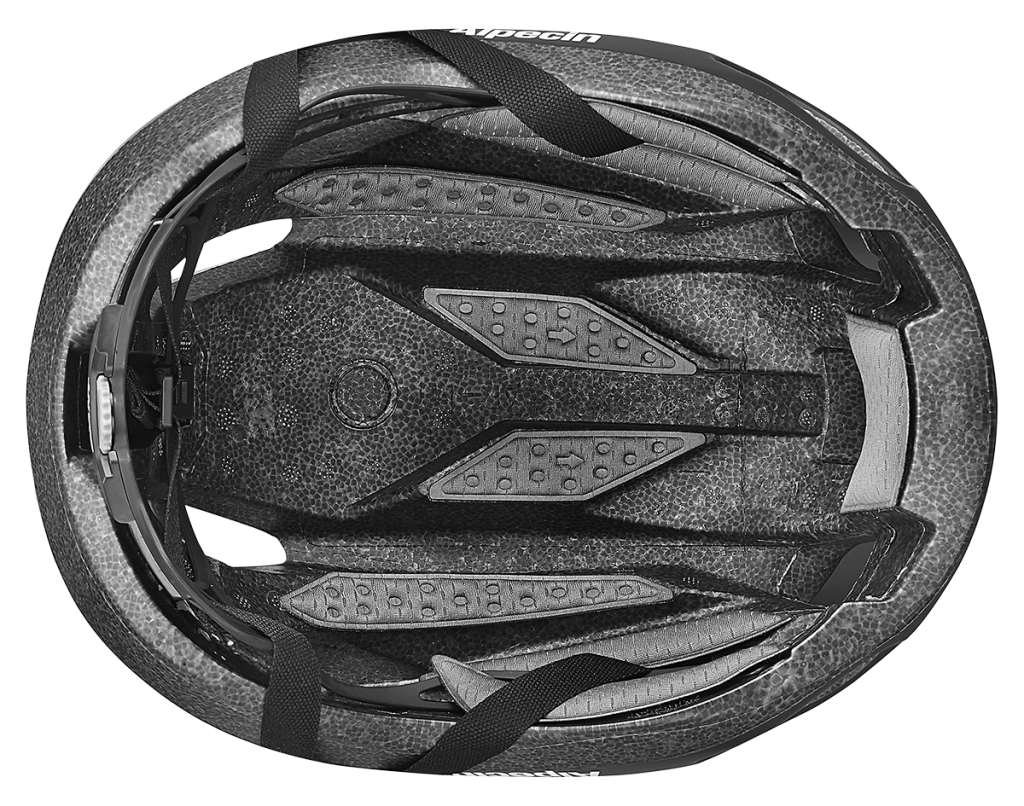
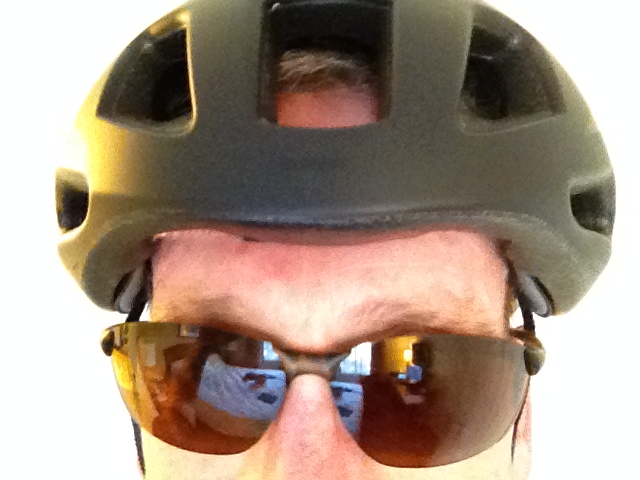
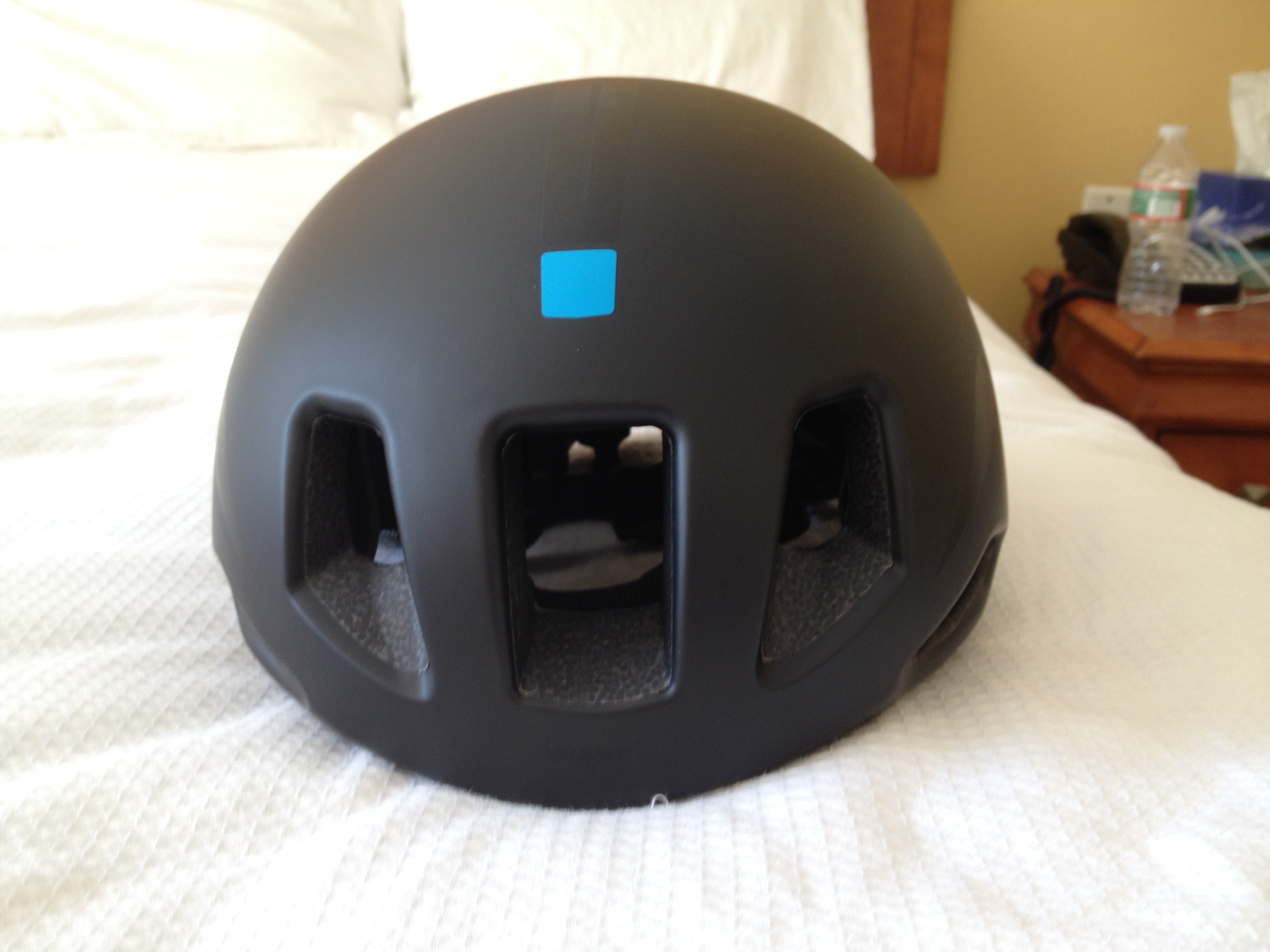
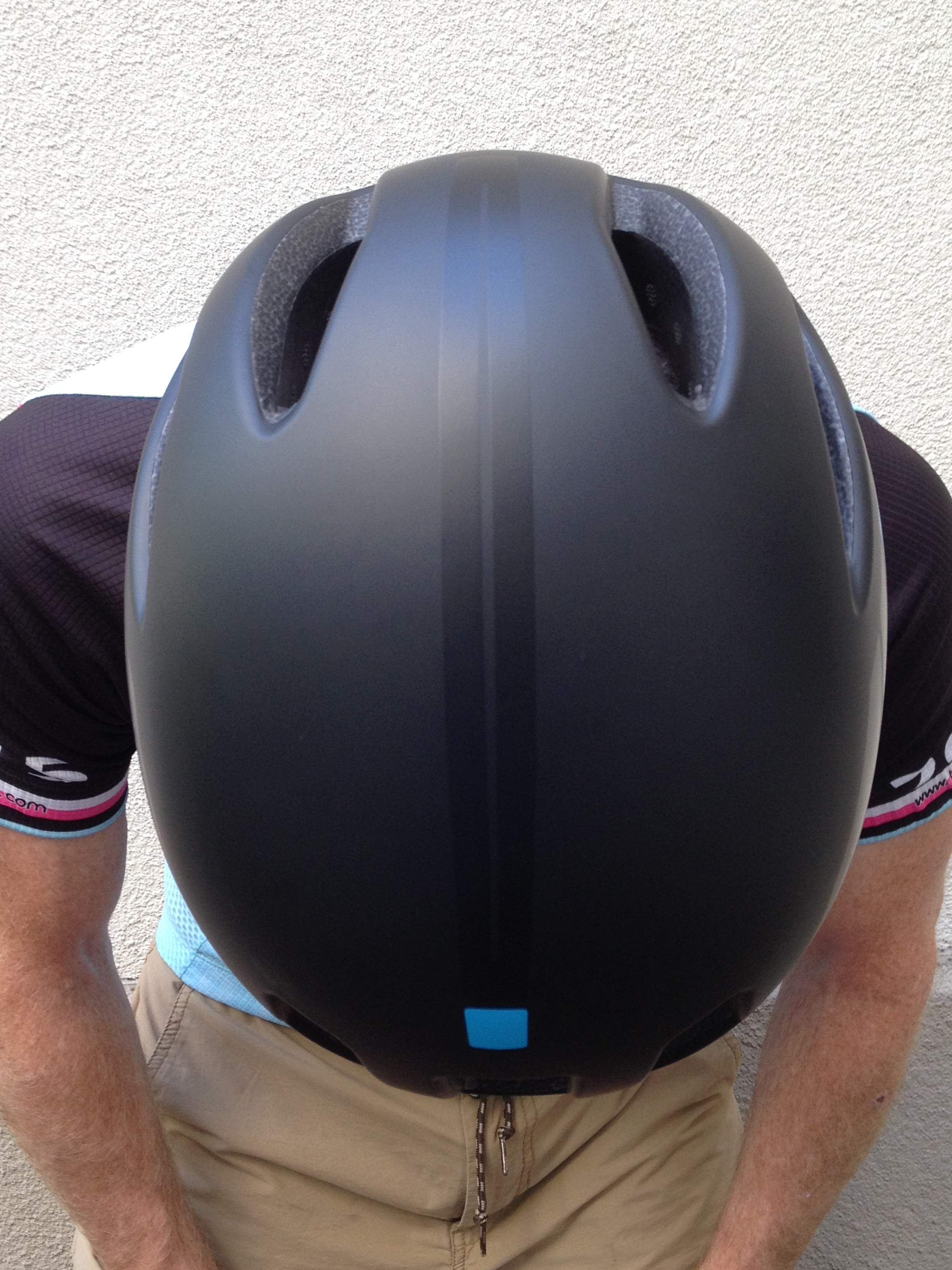
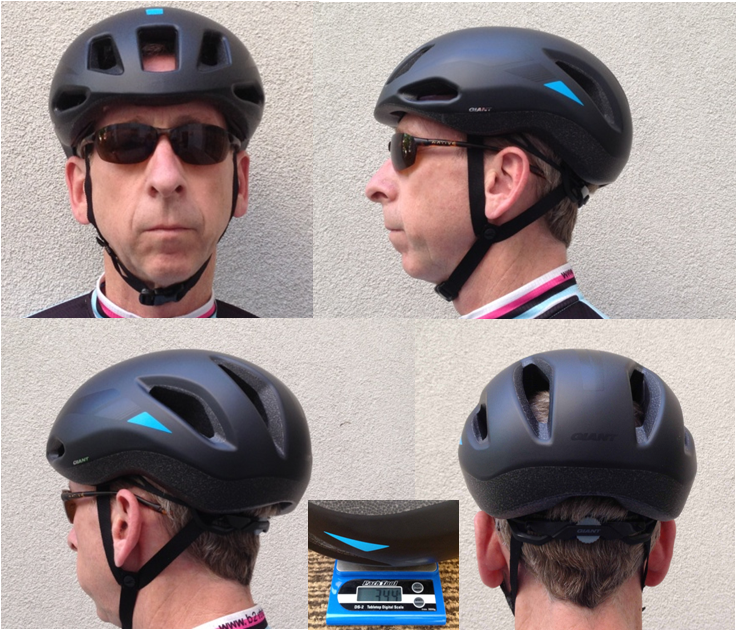
Hi Steve,
Love your site and I’ve used it to inform every piece of upgrade I’ve decided on, including components, wheelset, and shoes. I’d like to suggest an update, if possible. Or maybe an add on for a few helmets that have been j troduced since the 2015 season, including the Cadence and the Boost 01.
Thanks!
Middle Aged Man River, Thanks for your kind feedback. Made my day! Thanks also for those two good suggestions. I’ll add those to my list of helmets to add in the next update, hopefully before you become Old Man River… Best, Steve
I agree with Middle Aged Man River. I‘m also looking at the Rudy Project Boost 01. I am a fan of Rudy products and own a few. The Boost 01 is the fan favorite in Kona, and the infomercial seems pretty informative and “convincing”. Looking forward to Steve’s update that will include the Rudy Project Boost 01. Thanks!
Hello Fellow Enthusiasts,
For those of you who may be wondering, the exclusive ITK10 discount code for In The Know Cycling readers at PBK UK is still very much alive. You simply need to go to PBK UK from any link on this site and it will work fine. You can find links to PBK UK in the right hand column of any page on this site.
The code will no longer be accepted if you go to the PBK site directly or through a site other than this one. This avoids other sites from publishing the ITK10 code and PBK providing discounts that were intended exclusively for ITKC readers.
Thanks,
Steve
Hi Steve, have you had a chance to use the new POC Ventral aero-Road helmet? I’m curious as to how it measures up against the Protone and Evade. Thanks!
Jason, Not yet. I do plan to test it this spring to add to this review. Steve
Steve,
Have you had a chance to ride with the Kask Valegro helmet. I’ve heard it’s supposed to be slightly cooler on hot days than the Protone and am on the fence regarding which of the two to get.
Brian, I haven’t ridden the Valegro. I can tell you that I just came back from a century ride with 6200 feet of climbing. The temp was 70 at the start and 85 for the last few hours. Wore the Protone and was cool throughout the ride. Steve
Thanks Steve, good to know. Do you think it would be comfortable even around 90-95 degrees?
Your’re kidding right? I don’t find cycling very comfortable at 95 degrees. I guess if you go fast enough, you can cool yourself down at any temperature.
Ha ha… true. Salt Lake City summers can get pretty hot – looks like 90s next week – at least it’s dry heat. Thanks again.
What about helmets from Poc? Did you consider any of those for your review or have any familiarity with them? Some riders I ride with have poc.
Jay, they came out after I did this review. Plan to add them when I update it this summer. Steve
Steve,
I’m 2+ years into my first helmet from Bontrager that I now realize is not that great for the kind of riding I’m doing. I’m thinking it’s time to upgrade. The people I’ve been riding with use poc, catlike brand helmets. I haven’t seen or noticed Kask. Are you familiar with the other brands and would Kask be your first choice for me to upgrade to?
Jay, I recommend the Protone. Steve
Thanks!